Portugal is one of my favorite countries in Europe. Prior to visiting Portugal, I figured a small little inlet that’s surrounded by Spain can’t have more than a week or two worth of sights to explore. Boy was I completely wrong. For as small as Portugal is, it packs an incredible amount of tourism punch.

There’s an almost frustratingly amount of things to do in Portugal that you certainly cannot hope to see it all in a week. From breathtaking beaches, to beautiful medieval towns, to cosmopolitan cities, to delicious wineries, there is so much that Portugal has to offer. Portuguese food is also an absolute dark horse for delicious European cuisines and you’ll want to make sure you prepare your appetite for the incredible flavors of the country.
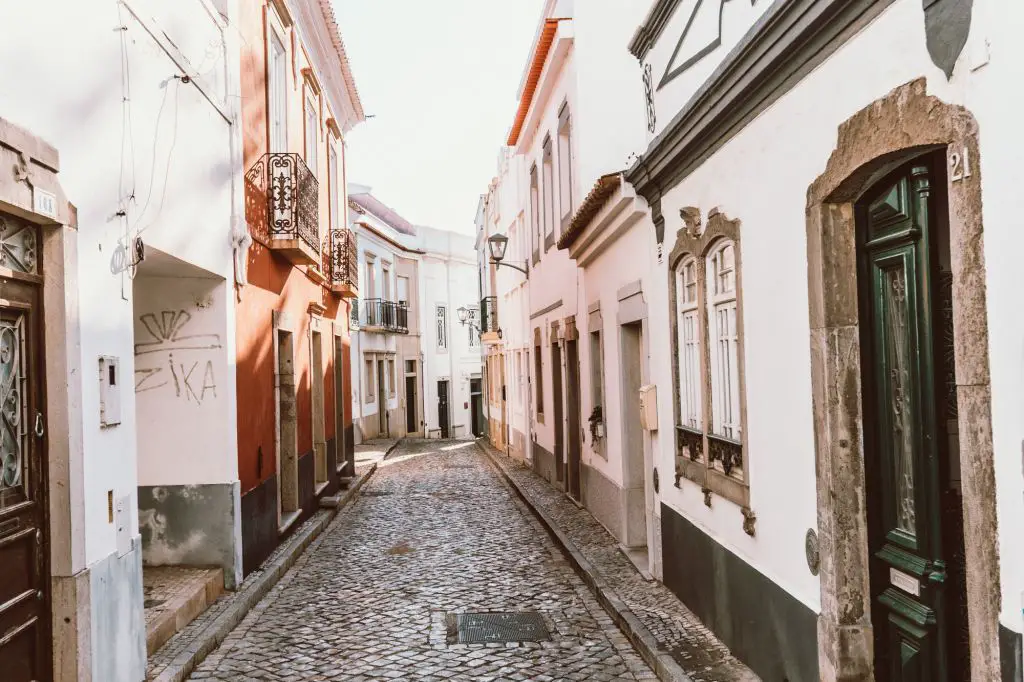
I’ve spent numerous weeks and weekends visiting Portugal on and off for the past few years. I’ve visited most of the areas of the country on different trips because I could never muster the amount of time it would take to see the whole country at once. Portugal is only 500km from north to south but the differences between the regions is stark and beautiful.
If you’re planning to visit Portugal, then this guide will have everything you’ll need to plan your trip. Whether it’s a weekend trip to the beautiful city of Lisbon, or a multi week road trip through the entire country, this guide will help you with your planning.
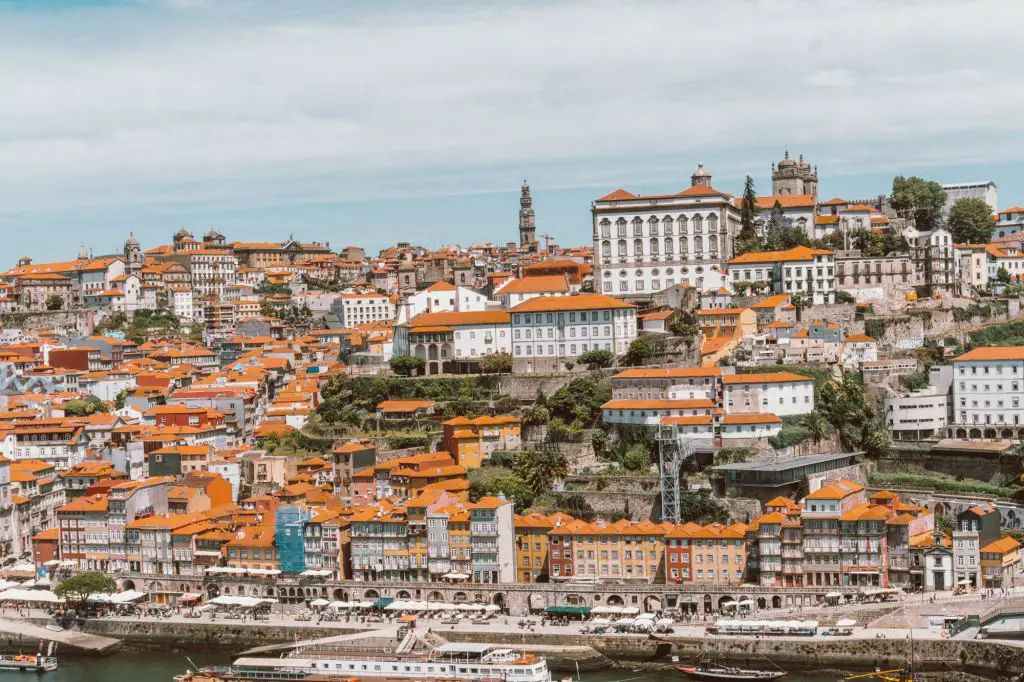
A list of all my Portugal posts:
- Travel Guide for Porto City
- Visiting the Douro Valley wine region
- Lisbon Travel Guide
- Best beaches in the Algarve
- Full Algarve Travel Itinerary
Where I went in Portugal
I’ve been to Portugal on numerous trips now. I really like the country and can totally see why it’s taken the tourism scene by storm in the last decade. It offers everything you’d want from a traditional European destination at an affordable price. I’ve ben to Portugal on three different trips: One to explore Porto and the Douro valley, one for Lisbon and the surrounding areas, and one for the southern Algarve coast.
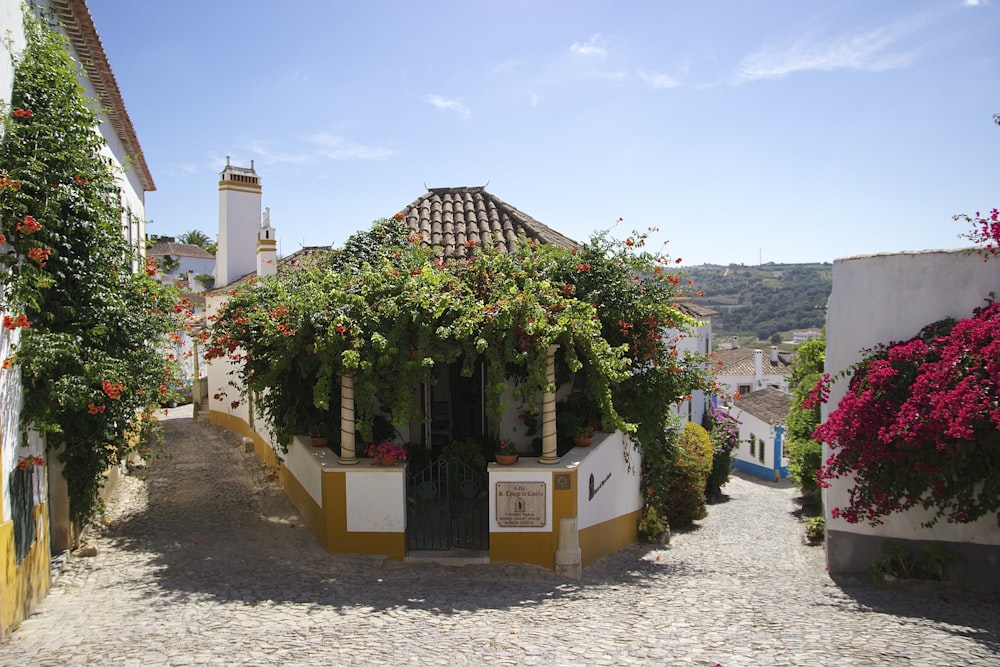
I did not do Portugal in one big trip but I’ve visited enough of the country now to know exactly how I would plan out my trip if I did want to do it in one fell swoop.
These are some of the highlights of my trip to Portugal:
- Porto
- Guimares
- Douro Valley wineries
- Coimbra
- Aviero
- Obidos
- Nazare
- Sintra
- Lisbon
- Setubal
- Alentejo Coast
- Algarve: Lagos, Carvoeiro, Ferragudo, Albufeira etc.
If these places sound like places you want to visit, then this is the itinerary for you! Of course, there are plenty of other smaller towns in Portugal that I did not explore because there is just too much to do and there’s so little time!
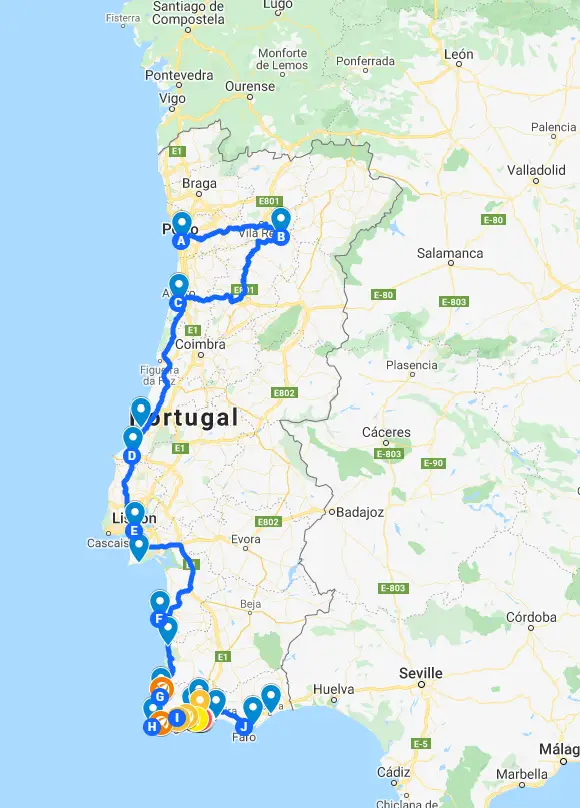
Portugal is incredibly diverse
Portugal is a tiny country but packs in so much. While the language is the same throughout the country, there are just so many historical sights, cute towns, different landscapes, and foods.
Food in Portugal
My oh my, the food in Portugal is absolutely amazing. Food is literally one of the main reasons I travel and Portugal has all the good stuff that I want to keep me happy. Like the landscapes and cultures, different foods are popular in different areas.

In the north, you’ll find more meat heavy dishes like the famous Francesinha or the to die for whole suckling pig called Leitao. I could eat Leitao for my last meal on Earth and I would be a happy man. In the south by the Algarve, you’ll find more seafood heavy dishes like Arroz con Marisco (seafood rice), octopus, and grilled peri peri chicken. You best believe that I ate a lot of that as well.
Then there are just overall Portuguese delicacies like the famous Pasteis de Nata, duck rice, secretos (Iberian pig meat), and more. I really didn’t know anything about Portuguese food before. I figured it would be similar to Spanish food and while there are similarities, there is just so much other stuff!
Planning a Portugal Road trip
Now that you know Portugal is a small country with incredible diversity of sights and sounds, it’s time to decide how you want to plan your trip. First thing is first, how much time do you have to allocate to this wonderful country?
If the answer is two to three weeks and you feel up for the challenge of seeing the whole country, then you need to plan your attack.
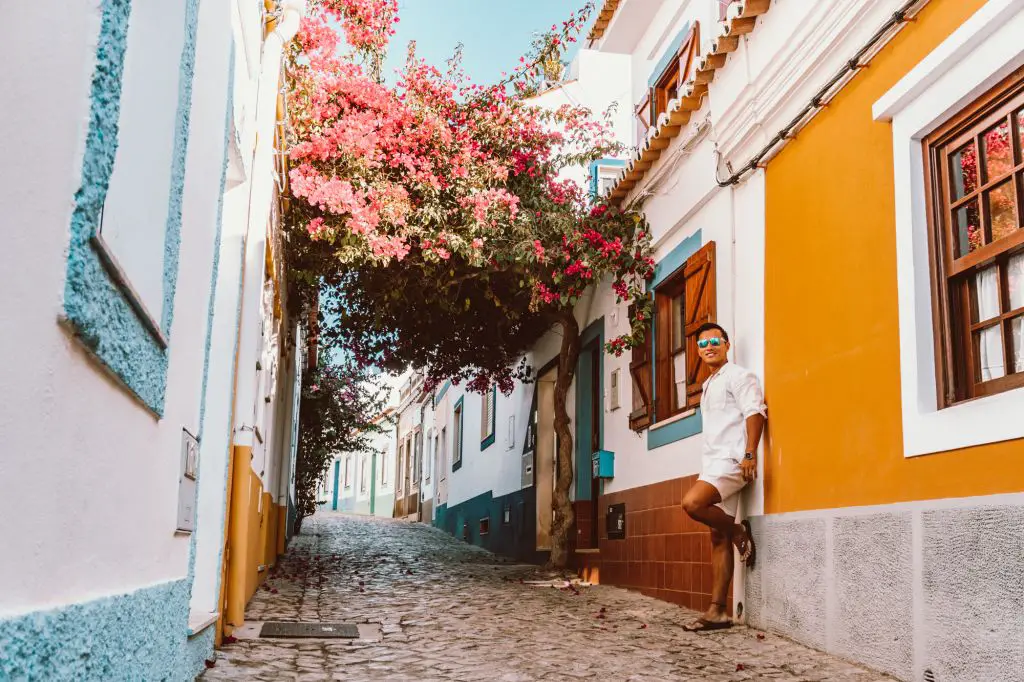
Lisbon is in the middle of the country
The problem with trying to see most of the country is that the capital city of Lisbon is in the middle of the country. Most international flights will arrive in Lisbon and from here, you’ll need to decide which way to go first. For the purposes of this post, the area around Lisbon includes places like Lisbon, Sesimbra, Setubal, Sintra, Nazare, Obidos, etc.
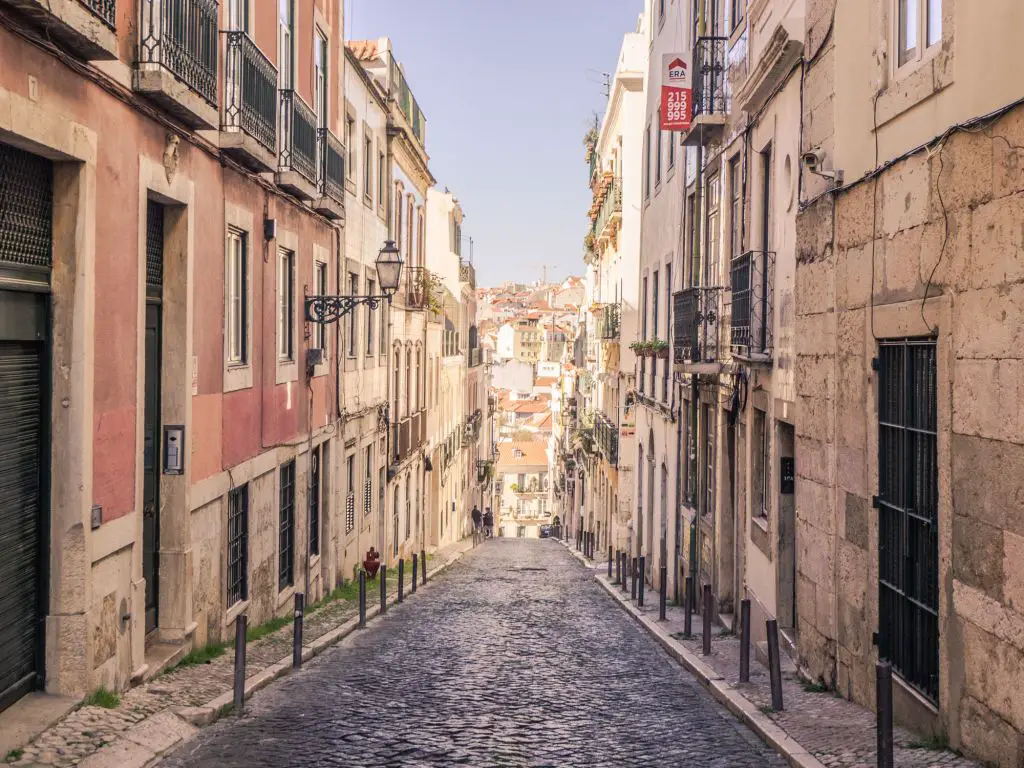
I think Lisbon is a must visit city and the surrounding areas are definitely worth the visit as well.
Porto and the Douro Valley are in the north of the country
Porto is the second biggest city in Portugal. It has that quintessential European beauty and the city is entirely different from Lisbon. There is always a budding rivalry between the two cities that you will inevitably hear about.
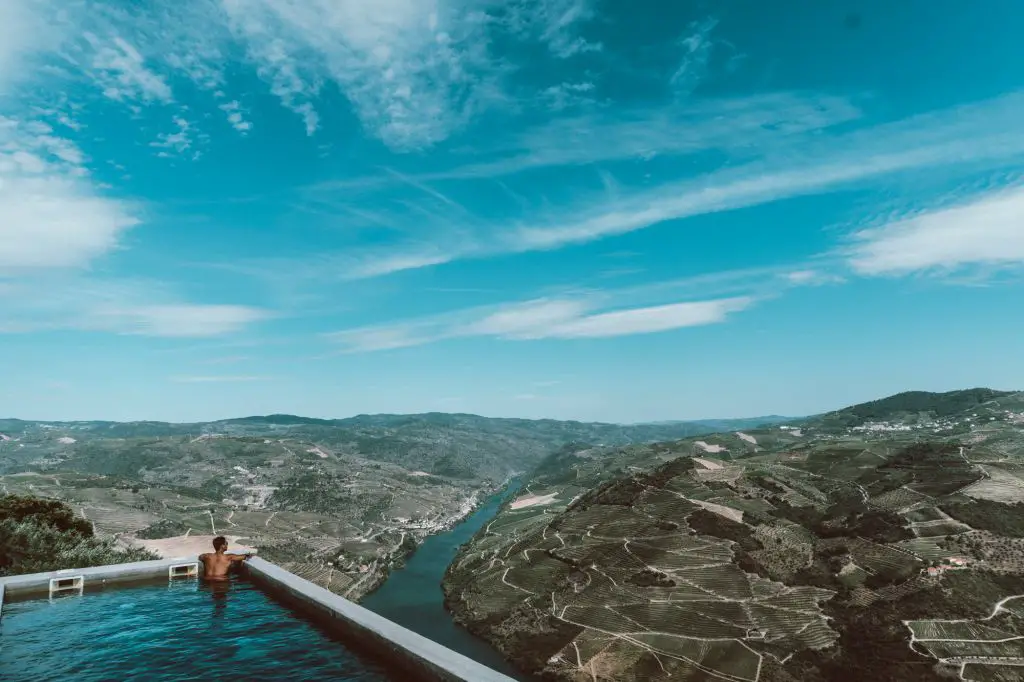
The areas around Porto include Porto city, the Douro valley which is Portugal’s most famous wine region, Aveiro, Guimares, Coimbra etc. Porto has an international airport with flights from North America and Europe.
Algarve and Alentejo is in the south of Portugal
Finally, the Algarve region of the southern Portugal coast is the area where you can expect to find the famous beaches of Portugal. Faro is the biggest city in the south with an airport servicing countries around Europe.
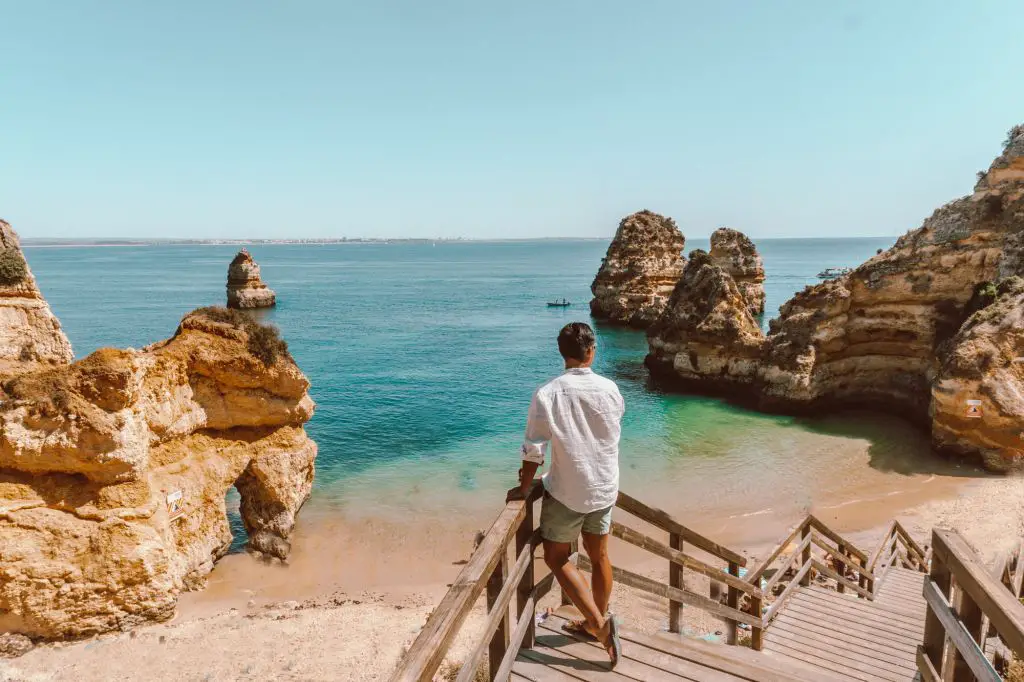
For the purposes of this post, I will also bunch in the Alentejo coast which is the southwestern coast of Portugal. I spent a week traveling the Algarve and it was fantastic.
Where to focus your time if you don’t have enough of it?
This is the eternal question for Portugal. I think you need at a minimum two weeks to see the entire country. You will mostly be speeding through everything but it’s definitely doable with two weeks. I would prefer to have three weeks so you can really enjoy the places you’re staying in.

If you only have one week, don’t even think about seeing the whole country as you’ll literally just be checking the boxes as you fly through the country. If you have anything under two weeks, I would focus on the Lisbon area because it’s likely you might be starting in that area, and then choose the north or the south.
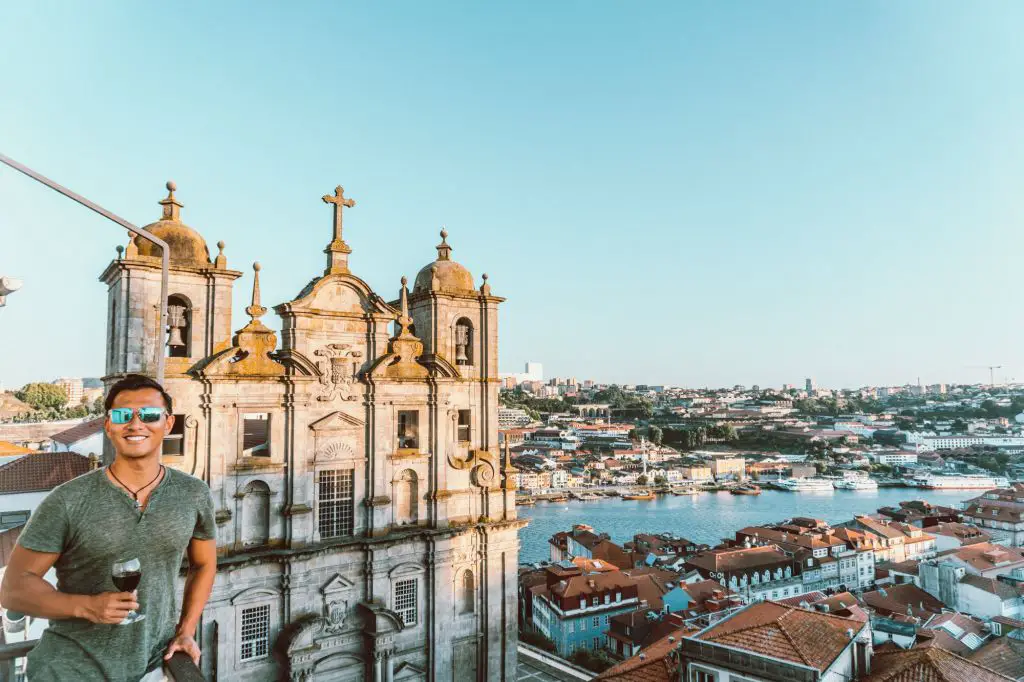
If you’re flying into Porto with less than two weeks, I would focus on the northern areas of course and then explore the central parts around Lisbon.
If possible, fly into Porto and this way you can drive all along the coast down towards the Algarve making your stops. The drive back from Faro to Porto is 5 hours. Better yet, get a one way car rental and then fly back from Faro to Porto.
Rent a car
The best way to see all of Portugal is by car. This is especially important when you visit places outside of the main cities. The roads in Portugal are in great condition including the major freeways as well as the smaller side roads. City traffic is not bad at all and the drivers in Portugal are mostly tame.
If you can’t rent a car, then it is also possible to do this itinerary at a slower pace. There are trains and buses that connect the major cities and run very frequently. From places like Lisbon, you can even use Uber or FreeNow to make day trips to places like Sintra or Sesimbra. However, for the purpose of this itinerary, I will focus on using a rental car as I find this to be the best way to explore Portugal.
Full Portugal Travel Itinerary
For the purpose of this itinerary, I will start off in Porto in the very north and work my way south to the Algarve for simplicity sake. Don’t worry, I’ll write about how to do all sorts of combinations of the trip depending on the length of time you have and where you’re starting your trip!
The trip starts in Porto, which is the second largest city and probably the more beautiful of the two major cities. I really enjoyed this city for its historical sights, beautiful streets, and of course the Port wine. Porto is the hub of all the Port produced in Portugal and you can drink at the numerous distilleries that are located in town.
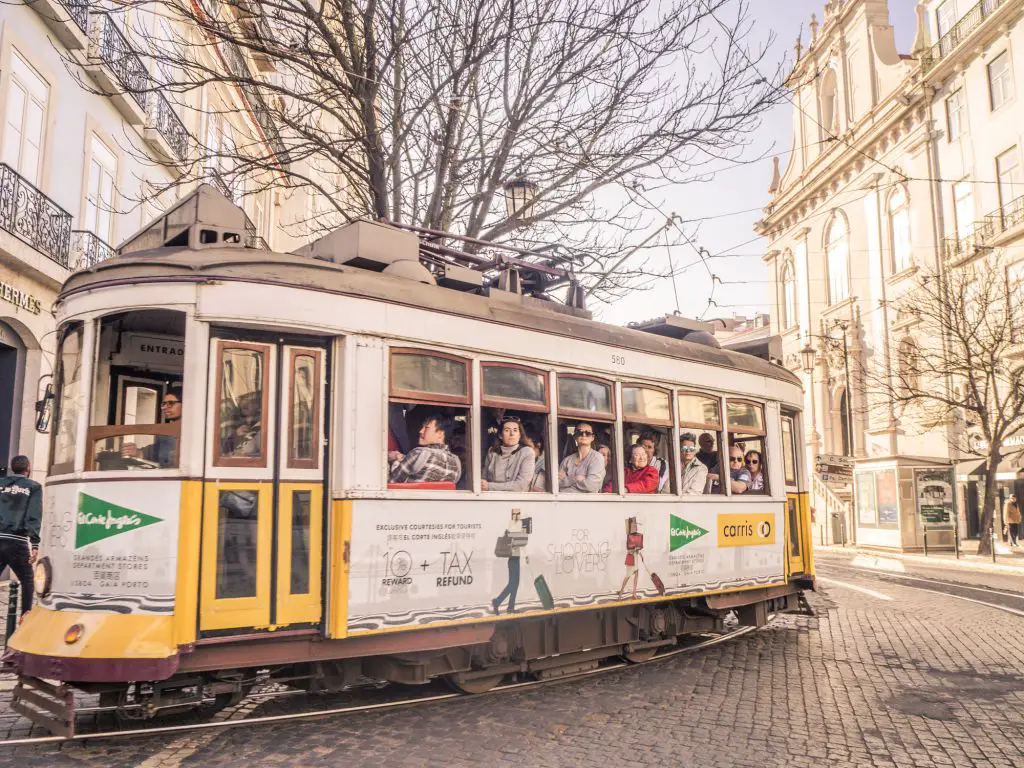
From Porto, I spent a day in Guimares which was the birthplace of Portuguese society. From here, I drove out to the Douro Valley to do a few days of wine tasting. The Douro Valley is absolutely stunning and is worth at the minimum a day trip from Porto. A lot of Portugal’s most famous wines are grown in the Douro Valley as well as the grapes used in the Port making process.
From the Douro Valley, I drop south towards Lisbon. Along the way, I stopped in Coimbra, the absolutely beautiful old town of Obidos, and the world famous surf town of Nazare. In Lisbon, I spent three nights exploring the capital and wish I had more.
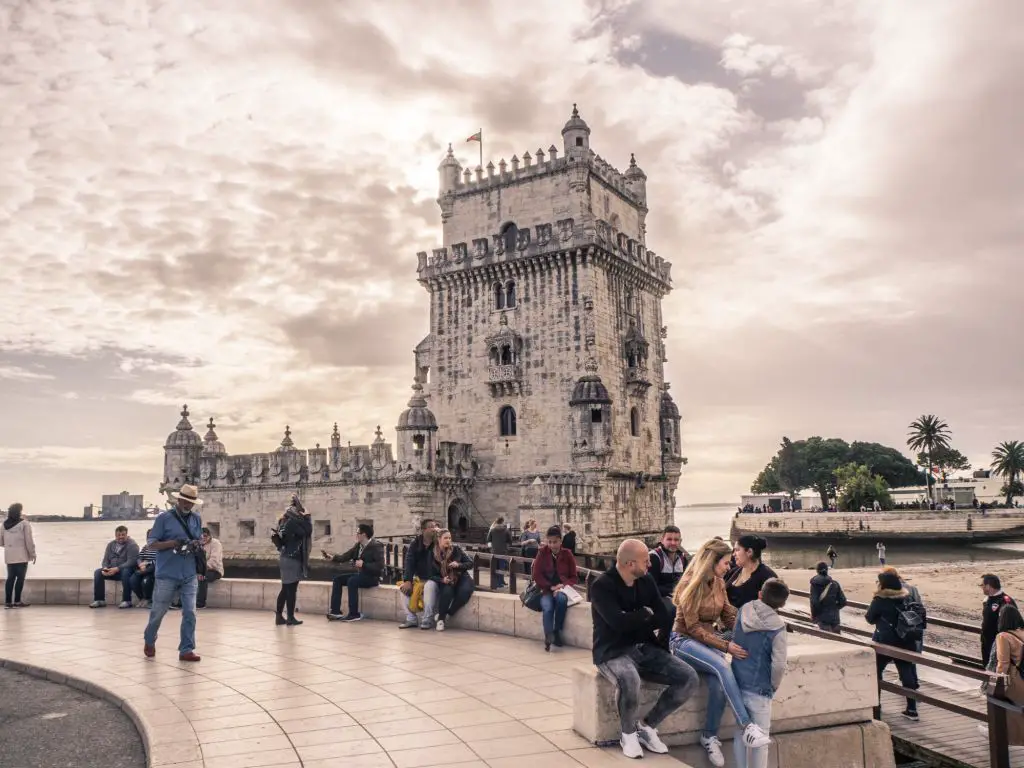
From Lisbon, I drove south through Sesimbra and Setubal, towards the Alentejo coastline which is also famous for their surf scene. Last but not least, I rounded the tip of Europe by visiting the Algarve. This included stops at numerous stunning beaches, as well as beautiful towns like Lagos, Ferragudo, Olhao, Carvoeiro and more.
From the Algarve, I drove straight back to Porto (about 5 hours) to drop off the car and fly home!
What about a one way drop for the rental car?
From looking at a map, you might be considering flying into Porto and flying out of Faro and renting a car one way. This is a good plan if you can pull it off. The thing is, most flights from Faro are only to continental Europe. If you need to fly back to North America for example, there are no flights from Faro to North America.
The better plan would be to fly into a place like Porto, do the itinerary as above, and then drop off the car in Lisbon. Faro to Porto is about 5 hours, whereas Faro to Lisbon is 2.5 hours. This will save you half the time but the costs of a one way drop and a multi-city flight might not outweigh the costs of simply driving another few hundred kilometers back to your starting point.
Need help planning your trip?
If you’re keen to visit beautiful Portugal and are feeling overwhelmed with the logistics of it all, I can definitely help! I’ve helped many of my readers plan their dream vacation, honeymoon, becoming a digital nomad and everything in between. If you’d like me to help plan your trip, please send me a message on my contact page and we can take it from there!
Day 1-3: Porto City
Porto, Portugal’s second largest city is also its most beautiful. It’s picturesque views and delicious food makes it a must visit for anyone visiting Portugal. It’s also the gateway to the breathtaking Douro Valley with all its wineries.
Porto is also home to the world famous Port Wine which is an integral part of the experience. The Douro river runs through the city bringing in oak barrels from the Douro Valley wine region. Don’t worry, I spent a lot time drinking Port so you’ll know exactly what to do. Porto also boasts some of the best restaurants in Portugal so you will never go hungry here. It is must visit stop in Portugal in my opinion and the first stop on the itinerary.
What to do in Porto?
Porto is a small city but packs a lot into its borders. It’s a city known for its history, culinary prowess, and of course Port. Before going further, one thing you need to understand is the difference between Porto and Gaia.
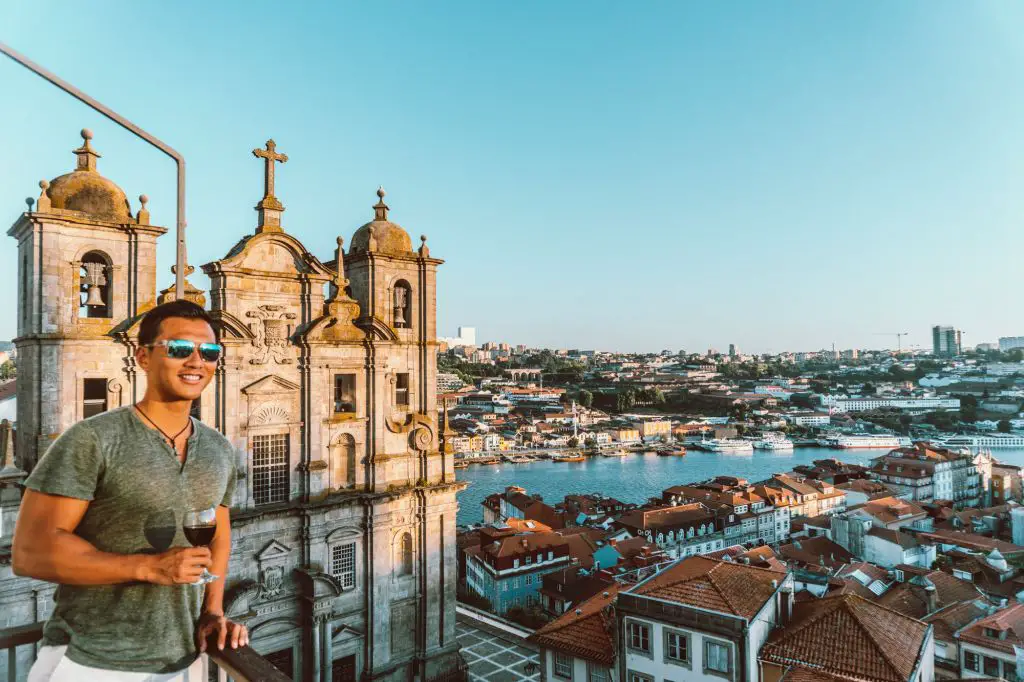
Porto vs Gaia, what is the difference?
One of the first things to understand is Porto from first glance is actually two difference cities. Porto city is on the north side of the Douro River and Gaia is on the south side of the city. It’s similar to Budapest with Buda and Pest on difference sides of the Danube.

The two cities are connected by the Dom Luis Bridge which of course is a must do activity. Porto is the main city. It’s where the old city is and where you will spend 80% of your time. All the beautiful cathedrals, historical landmarks, pretty Portuguese buildings are all on the Porto side.
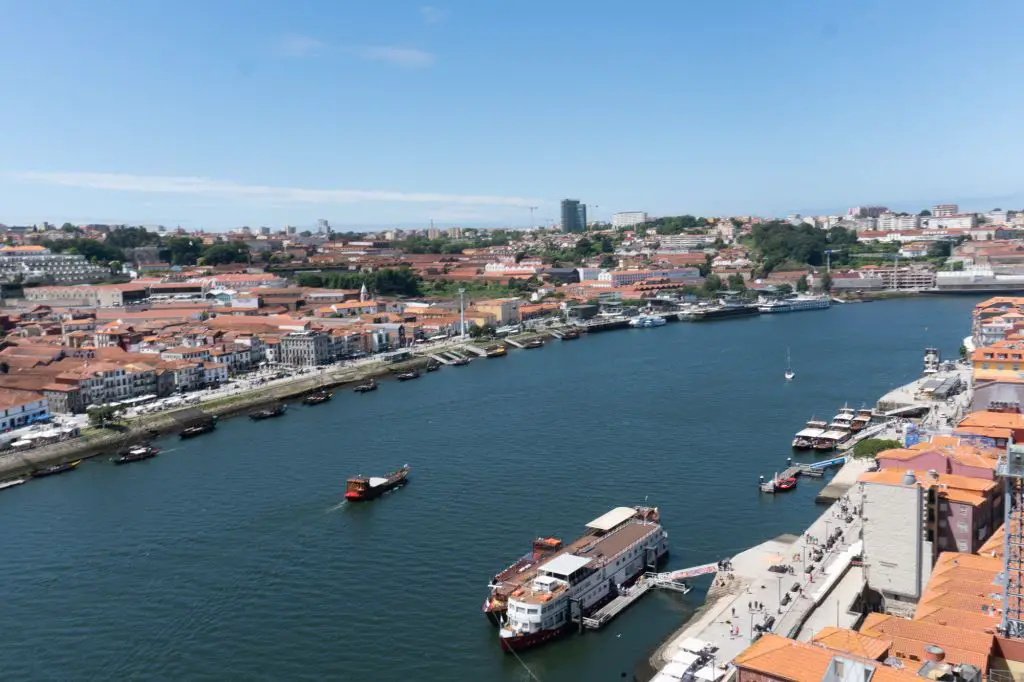
Gaia is where all the port cellars are. All the different companies making Port have their cellars on Gaia. None are actually in Porto. This is due to the fact that when these cellars were being established two hundred years ago, the taxes on the Gaia side were much lower and there was plenty of room to build. Porto had already been mostly built up and established so wine makers decided to use the side opposite the river for cheap land.
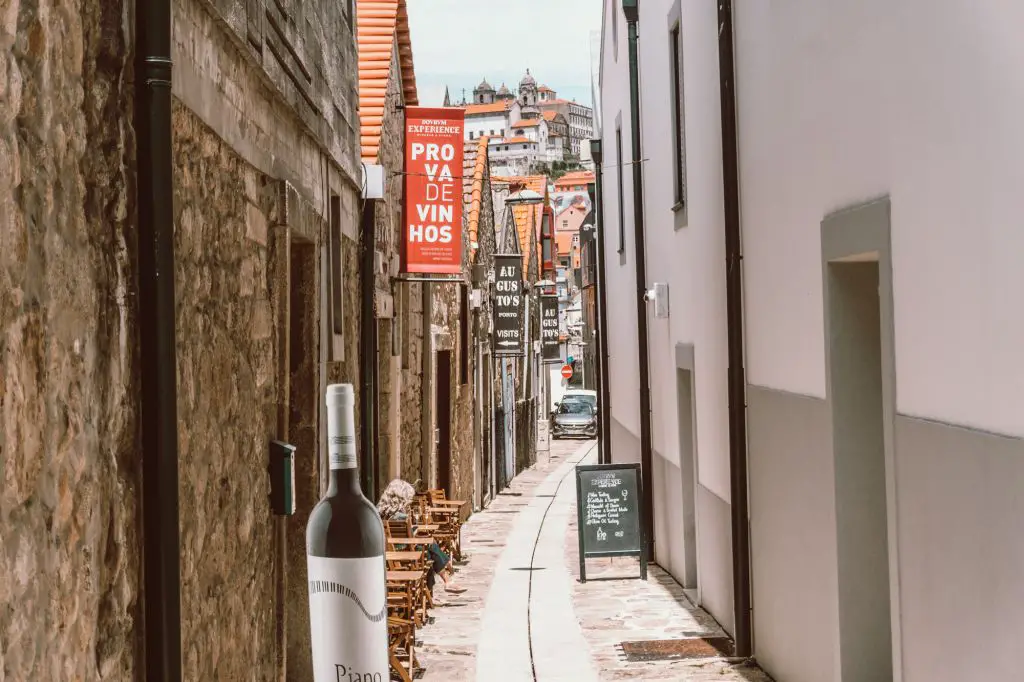
In addition, Port ages over many years and requires the ideal conditions. The Gaia side of the city does not receive as much sun making it more ideal to control the conditions for Port aging.
The tour guides like to bring up this fact that the two cities are very separate and there is some cute rivalry between the two. In reality, I don’t think any locals living in Porto in this day and age really care. They are right next to each other and many people live on the Gaia side because it is much cheaper than living in Porto.
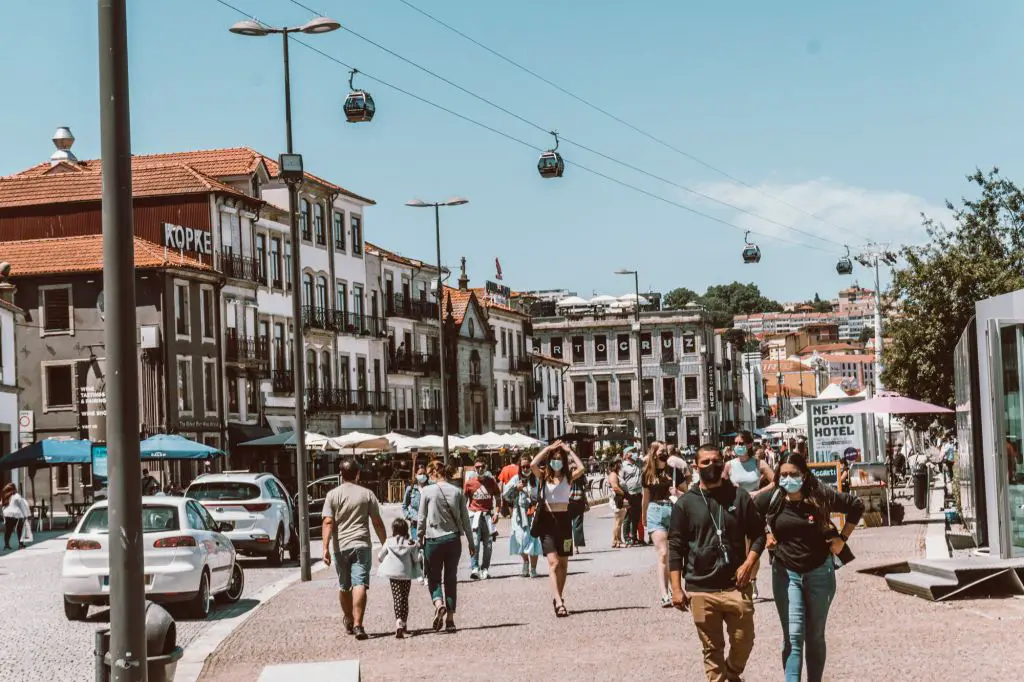
Walk around the city and enjoy the architecture
Unlike Lisbon, I was immediately attracted to the facade and cobblestone streets of Porto. Porto is Portugal’s second largest city and by far its most picturesque. While Lisbon is a more cosmopolitan and contemporary, Porto is its homogenous and most quintessential European city. From its cobblestone streets to its perfectly tiled houses and stucco rooftops, Porto is literally picture perfect in every way.
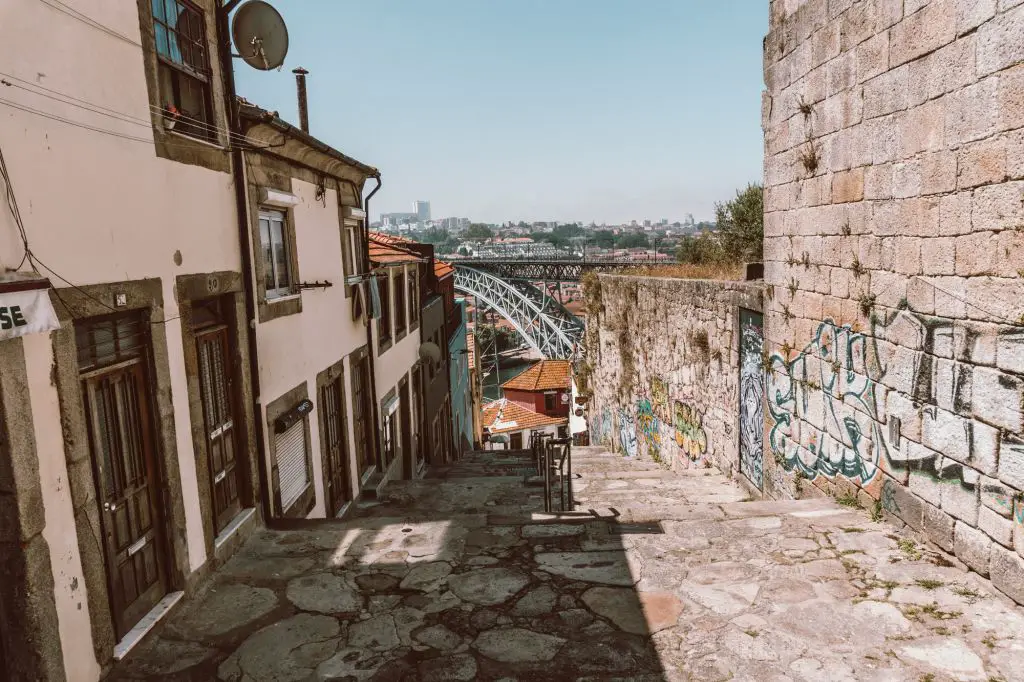
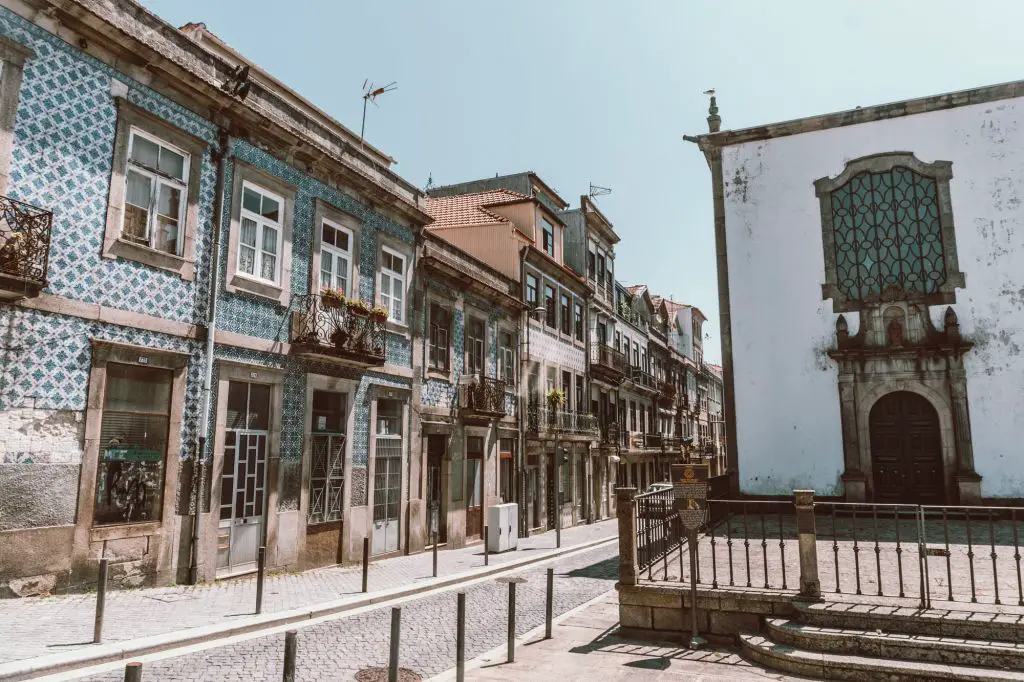


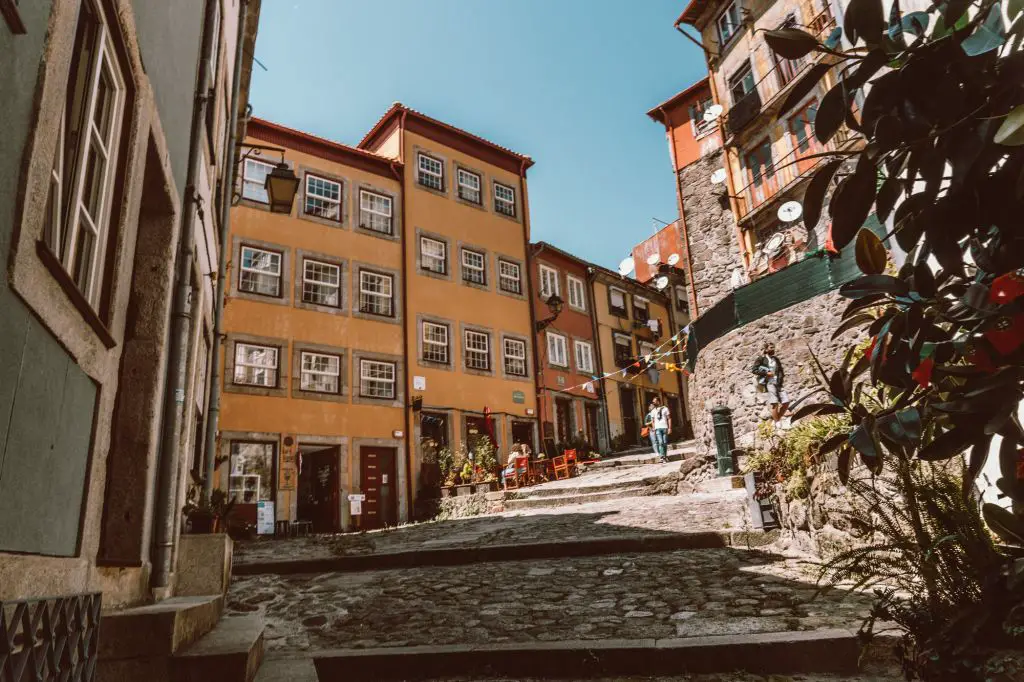
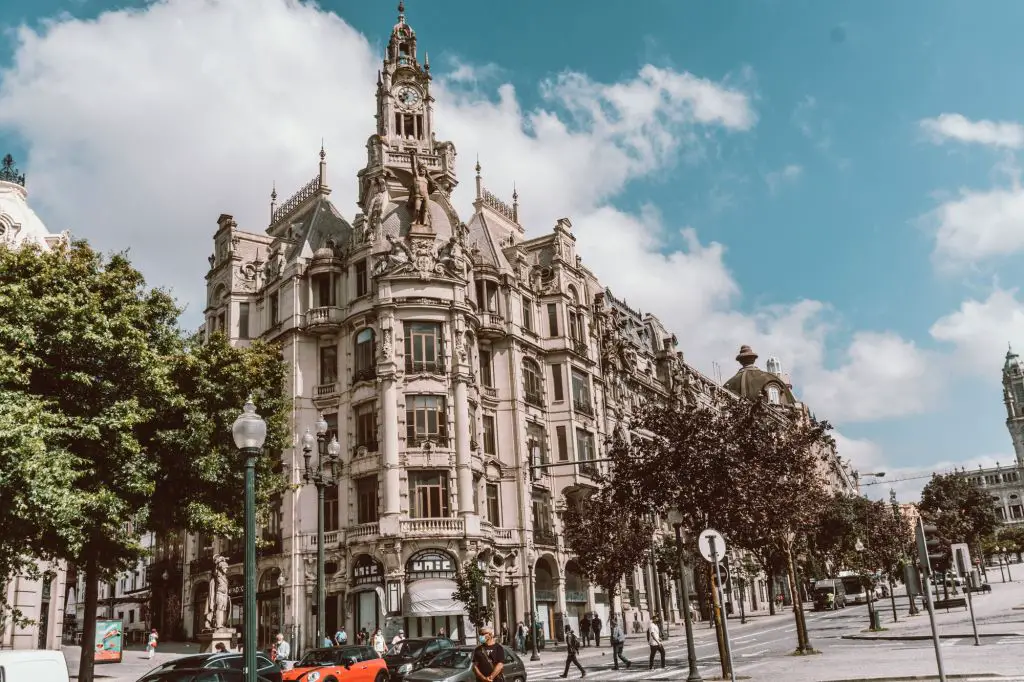
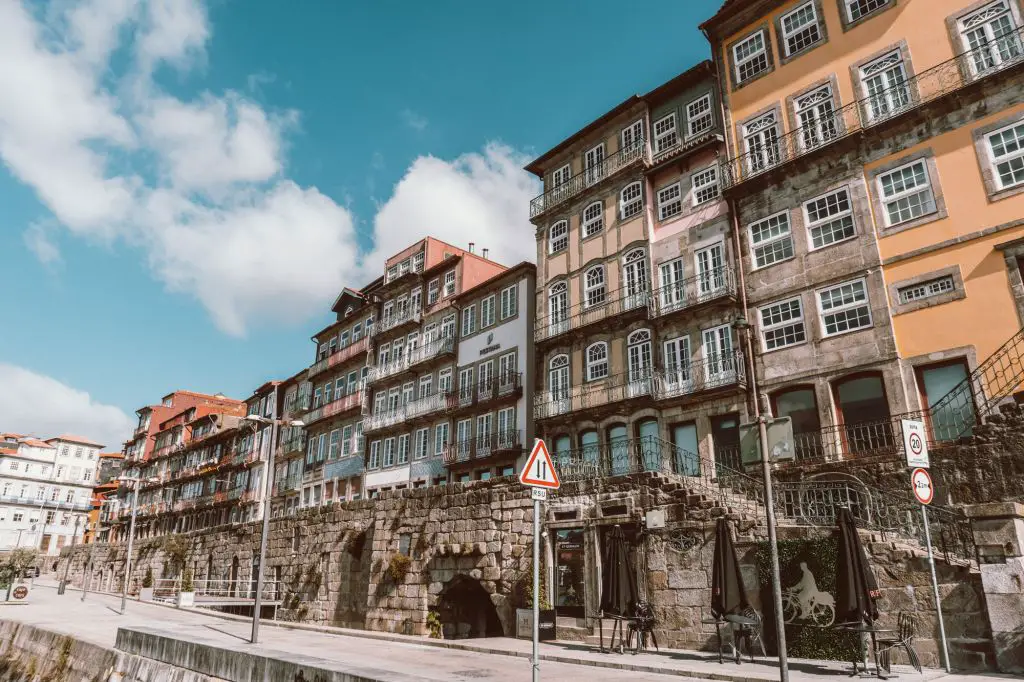
Simply walk through the streets of the old town and be prepared to snap photos at every turn. The city is quite hilly so be prepared to climb stairs.
Drink Port Wine in Gaia
You probably already know this but Porto is famous for its Port wine. This is the fortified dessert wine that has become famous worldwide. All of the major portmakers are in and around Porto. You will see from the Dom Luis Bridge all the numerous signs in Gaia representing different wineries.
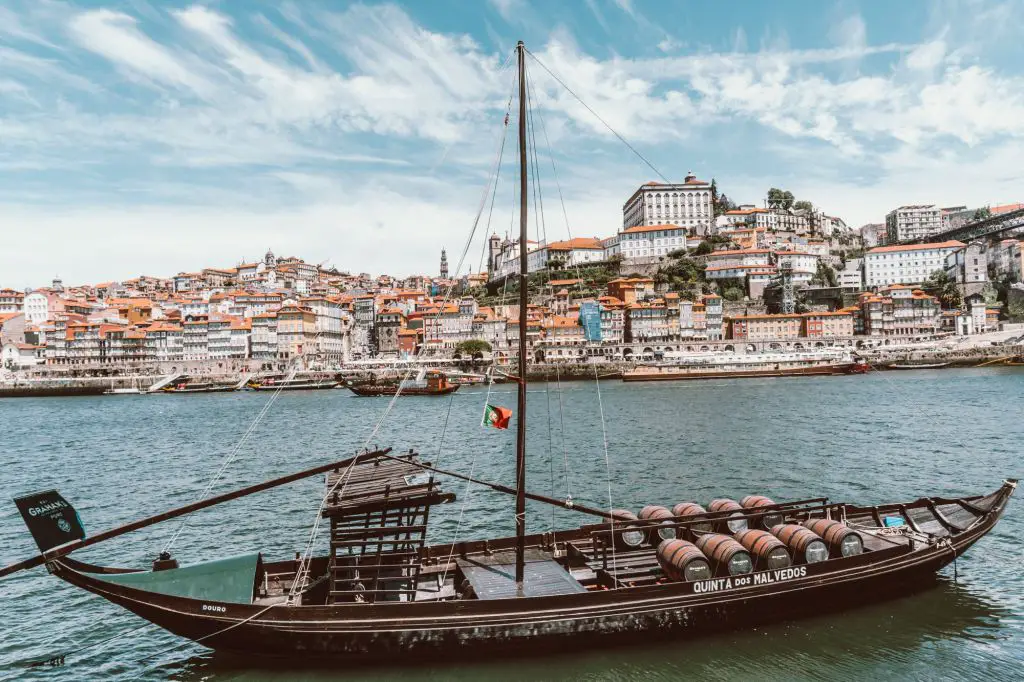
The grapes for port wine are grown in the Douro Valley which is just a few kilometers down the Douro River that splits Porto and Gaia. The wine is brought to Gaia where it is aged in the cellars located in their warehouses in the city. These giant buildings are also where you can do wine tasting and port tasting. There are dozens of cellars in Gaia and you can essentially just bounce around from one to the other. The all offer tastings, tours, and some even offer dining.
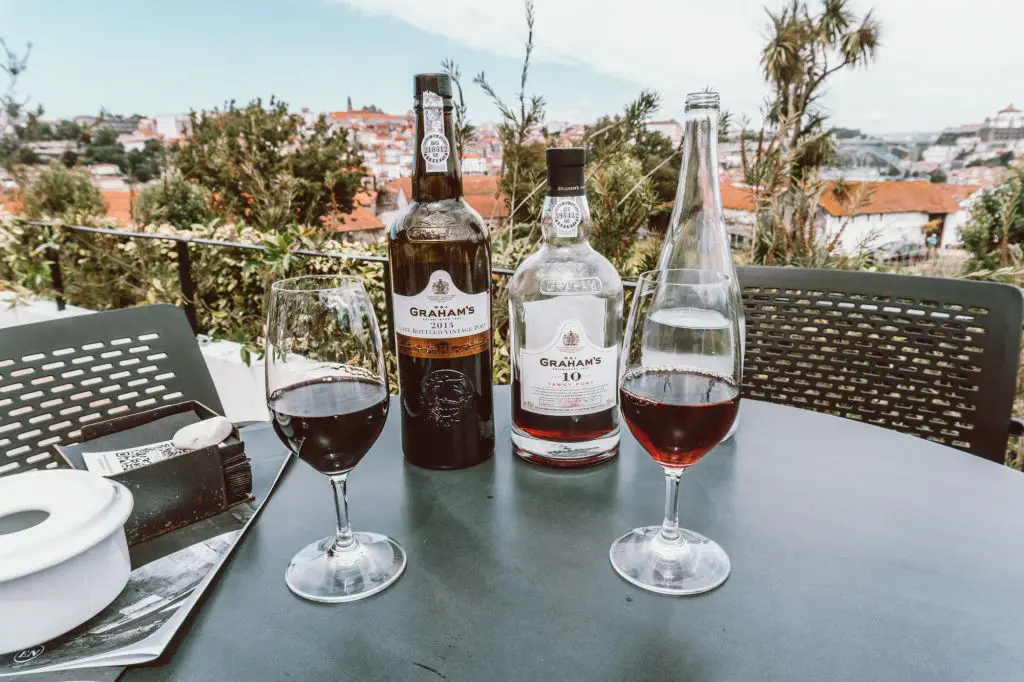
I’ve personally never drank much port in my life and turns out I actually quite enjoy a good port. There are tons of different varieties of Port ranging in all sorts of costs.
What else to do in the Porto?
There is so much to do in Porto that it can easily be turned into many more days. Some things of note are:
- Visit the Porto Cathedral
- Have a coffee at the Majestic Cafe (the inspiration for Harry Potter)
- Livraria Lello
- Porto Walking tour
- Port drinking tour in Gaia
Make sure to read my full Porto travel guide which will go into detail about all the places I went and the food I ate.
Day 4: Guimares and Braga
From Porto, I wanted to visit the towns of Guimares and Braga which are considered to the beginning of Portuguese society. Both towns are charming and well worth the visit in my opinion.
Guimares
Portugal’s first beautifully preserved capital, Guimarães, is a 45-minute drive from Porto. In the center of it is an ancient city dotted with cobbled alleys and stone slabs made of 14th-century buildings and metal balconies.
UNESCO named the historic quarter a World Heritage Site in recognition of its unchanging architecture and its central role in Portuguese history – not only the country’s first capital, but also the birthplace of its first king, Afonso Henriques.
The 11th-century palace where the future king was born is still a stronghold located near the city. Its ramparts pierced by seven powerful towers dictate the views of the city with its red roof and the more hilly countryside, walking at a distance. Nearby, you will find Igreja de São Miguel de Castelo, a squat and an open Romanesque church that is claimed to be the place where Afonso was baptized.
A short walk is the Paço do Duques de Bragança, a 15th-century palace that was also home to the Salazar presidency. On a tour of the high-rise apartments, you can see a collection of medieval weapons and large tapestries.
Braga
Portugal’s religious capital, Braga, is a conservative city known for its extensive demonstration of Semana Santa (Holy Week) with its historic base, dominated by a multitude of Baroque churches. A visit here with nearby Guimarães makes for an easy one-day trip from Porto.
Founded by the Romans in the far north of the country, Braga still shows the effects of the empire. Maximinus Roman Thermae – known locally as Termas Romanas do Alto Cividade – is a 2nd century bath complex and includes several large buildings. You can visit the ruins, which is still a mining site.
The old historic city has wide palaces and sidewalks with fountains and flower beds. The streets are lined with gray stone buildings, colorful townhouses, fashion restaurants and designer boutiques, as well as restaurants that spill over into stone.
The city is home to the largest church in the country, a race structure that began 1,000 years ago.
Day 5-6: Douro Valley
From Guimares, it is time to go to the Douro Valley to embrace all that Portuguese wine tasting has to offer. Portugal is a country of wine and there are numerous wine regions in this little country but the Douro Valley is by far the most well known. It is also in my opinion, the most visually stunning of the different regions.
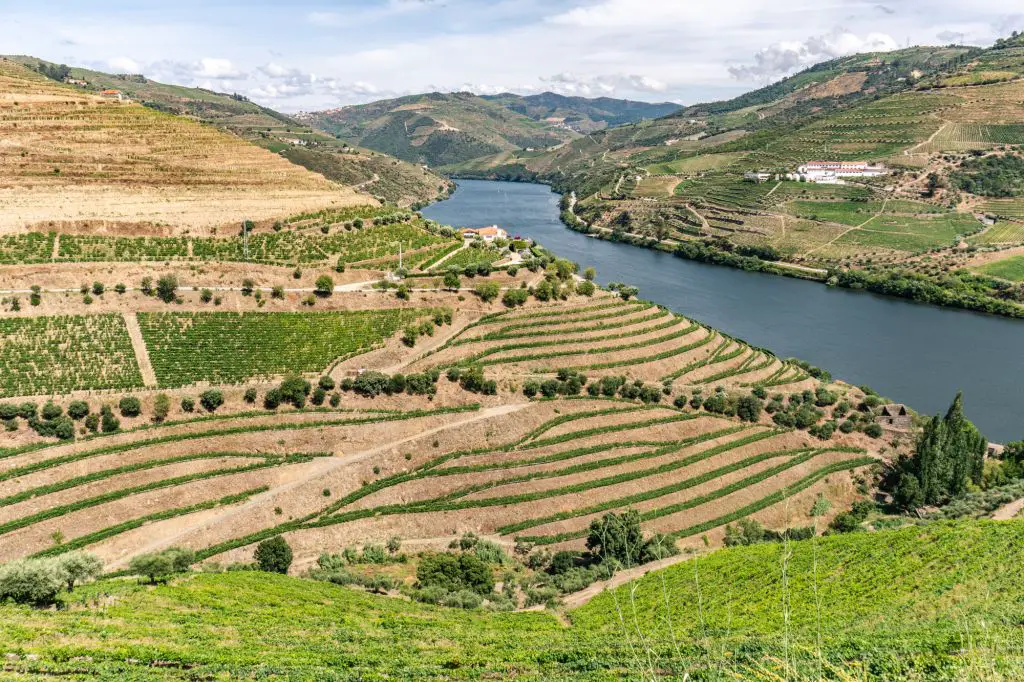
The huge rolling hills with wine terroirs really define this region. It reminds me a lot of the Mosel river wine region in Germany but with even larger and dramatic hills.
This is where a car is a must have as getting between wineries requires a car.
Go wine tasting in the Douro Valley
Wine tasting in the Douro Valley is spectacular. Simply follow the Douro River from Porto out to the wine country. It’s about 1 hour from Porto and you’ll be able to witness very amazing scenery along the way.
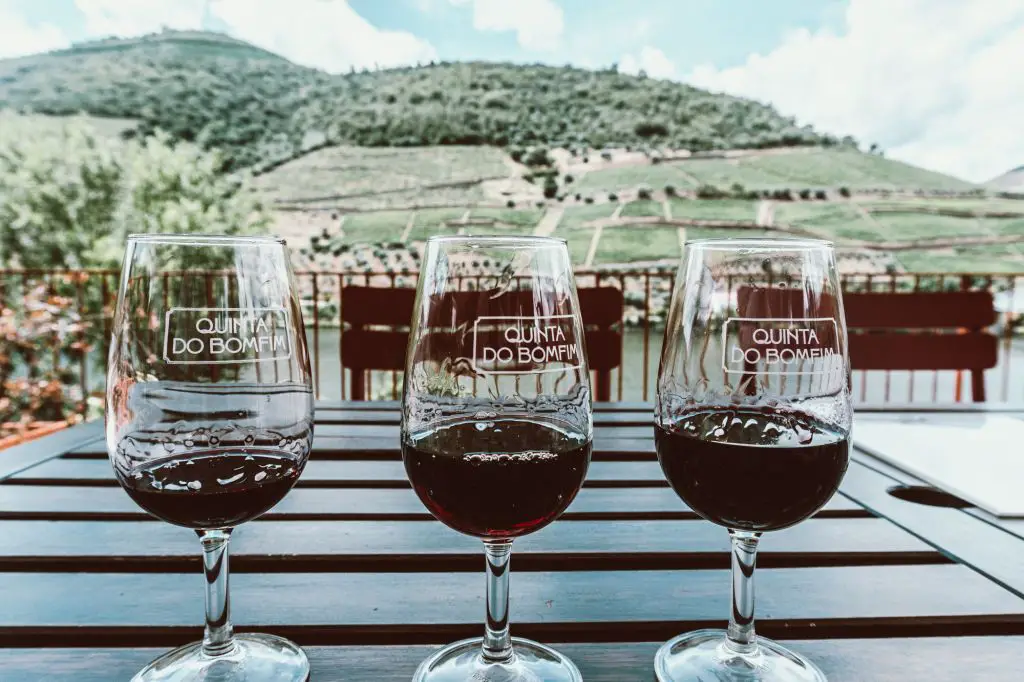
The wine tasting scene in the Douro Valley is casual and laid back. You don’t need reservations at many places and you can simply show up and enjoy their wine and port. Some of my favorite wineries to visit are the following:
- Quinta Do Popa
- Quinta do Seixo
- Croft Port
- Quinta das Carvalhas
- Quinta de la Rosa
- Quinta Novo
Quinta do Popa had an especially beautiful view of the Douro river that I absolutely loved drinking wine from.
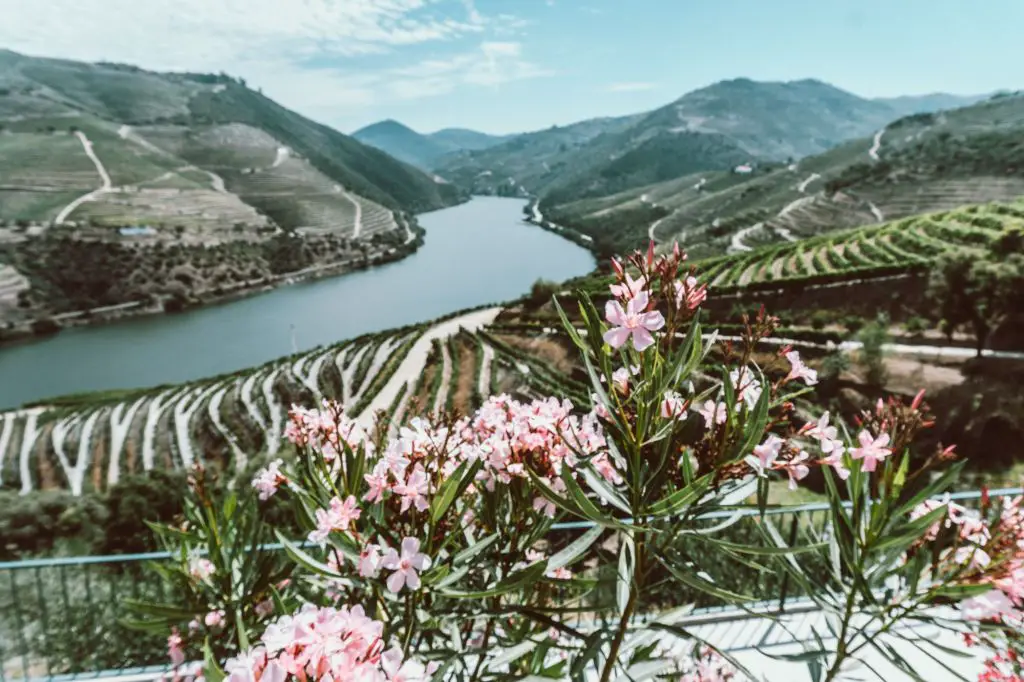
Where to stay in the Douro Valley
There are countless Quintas and guesthouses with accommodation options in the valley. The Douro Valley is generally seen as a more expensive destination within Portugal so you will pay more here in comparison to other locations.
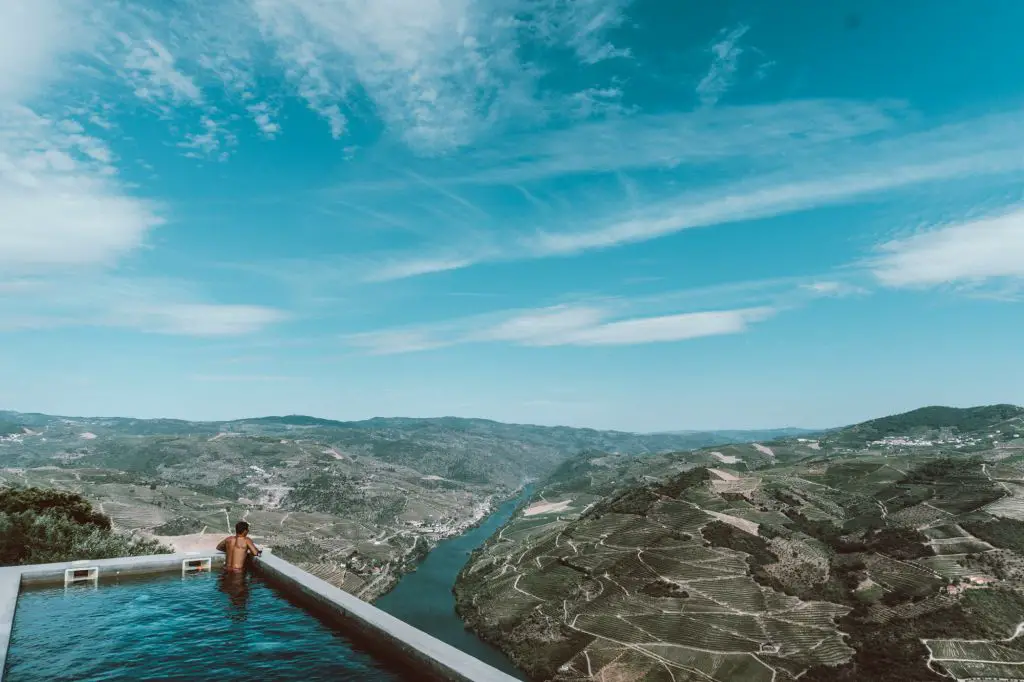
After starting my search, I saw many Quintas located on the hillside with beautiful pools that overlook the river and valley. I knew this was what I wanted and went to look through the numerous hotels that offered this.
Quinta De Santa Marinha
I ended up settling on the Quinta De Santa Marinha. This hotel was relatively cheap in comparison to other options, and had stunning views of the valley.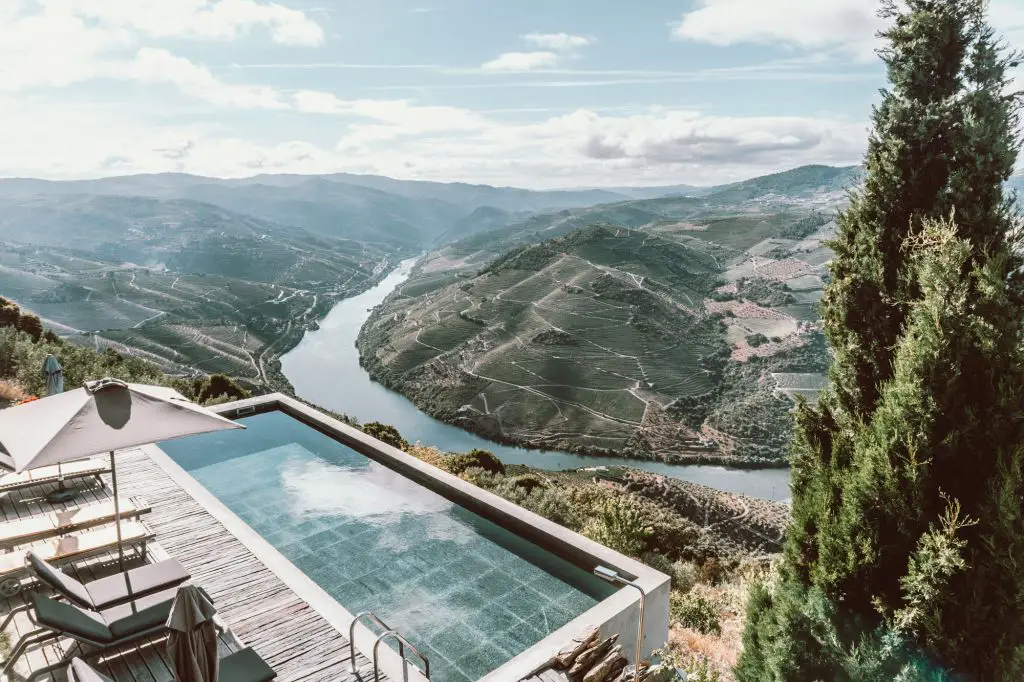

Upon arriving, I can confirm that the views were completely out of this world. It was higher up than other hotels and you could see so much of the surrounding landscape. From the pool, it was bliss and an amazing place to waste the day away.
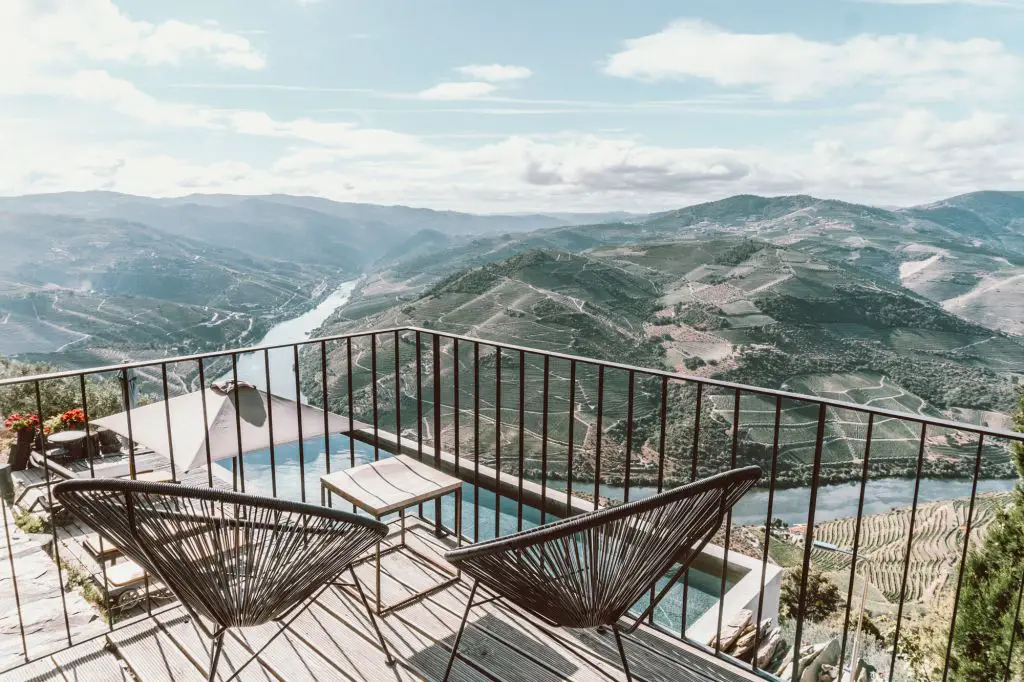
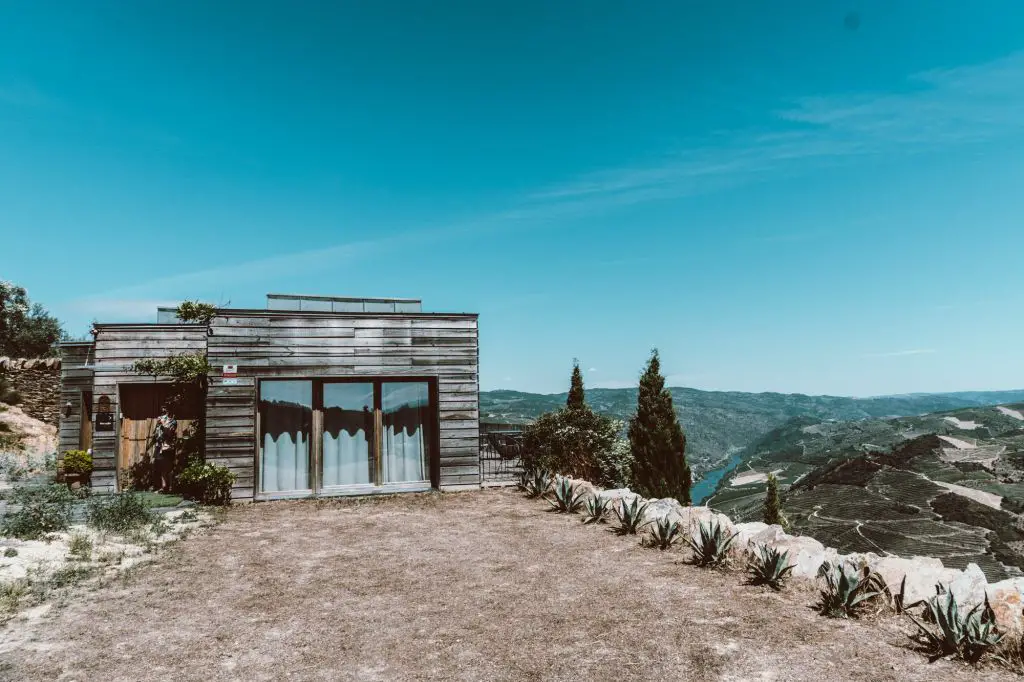
The traditional breakfasts were also a delight to have in the morning before setting out to wine taste.
Day 7: Coimbra, Nazare, Obidos
Day seven is finally leaving the northern part of Portugal to drive southward to Lisbon. I did this day quite fast stopping in the towns of Coimbra and Nazare before settling down in Obidos for the night.
Aveiro
Known as the Venice of Portugal, Aveiro is surrounded by salt-flats, beaches and lagoons and dominated by the Central Canal running through town. Once a big sea port, Aveiro lies in a region of valleys cut by mountains and fertile lagoon plains.
The city of Aveiro is crossed by canals, which give it quite an individual character, and in the old quarter tourists can see the quaint whitewashed houses of the fishermen and visit, early in the morning, the Mercado do Peixe, an auction of the fish caught during the night. Of all the boats seen in the area, the moliceiro is the most elegant, being perfectly lined, painted with bright colours and with often ingenious and humorous decorations.
Nazare
Nazare is a seaside town half way between Porto and Lisbon. It’s an incredibly beautiful town with some of the most dramatic views over the ocean you can find. There is a viewpoint hundreds of meters above sea level where you can overlook the huge Atlantic waves crashing into the beach and town.
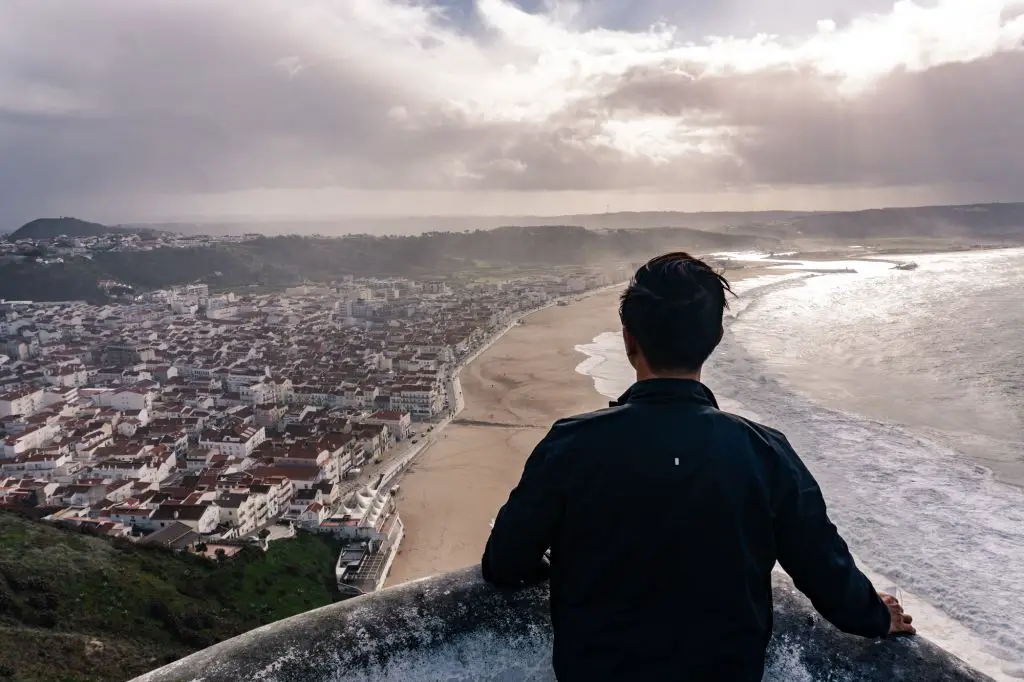
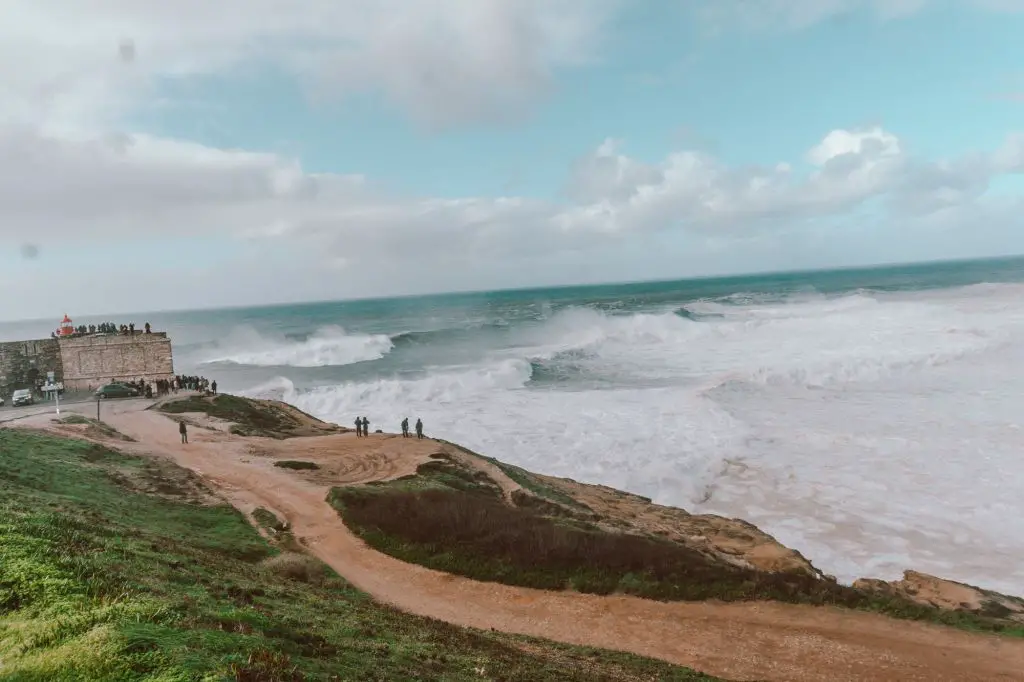
I didn’t spend much time in Nazare but simply wanted to visit because of its enormous waves. Nazare is home to the biggest waves in the world and holds the record for the highest wave ever surfed. Waves here can reach 30 meters and more in the winter months which is absolutely monstrous! I first heard of Nazare after watching a YouTube video of Garrett McNamura surfing this enormous wave that looked out of this world.
While you’re not guaranteed to see monster waves like this, in the winter months you will be sure to see huge waves you’ve never seen before. Visit the Fort of Sao Miguel Arcanjo where you can walk up to the top and have views of the ocean. You can see the monster waves crashing into the beach which is a truly special sight to be behold.
Obidos
Obidos is perhaps the most historical and most beautiful village in all of Portugal. I’m sure there are are others but this is just the one I found! Obidos is like Rothenburg ob der Tauber in Germany which is the most quintessential yet touristy old town the country has to offer.
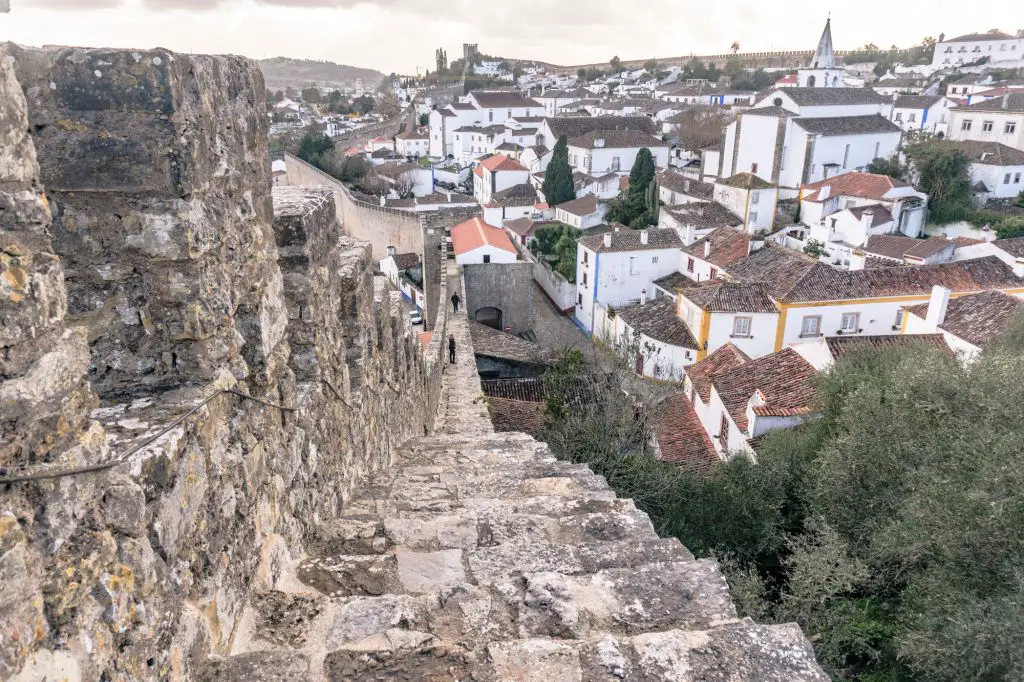
First remarked upon for its beauty by the 13th century Queen Isabel de Aragon, Óbidos was presented to her as a gift by her romantically inclined husband King Dinis and thenceforth it has been offered by princes to their brides.
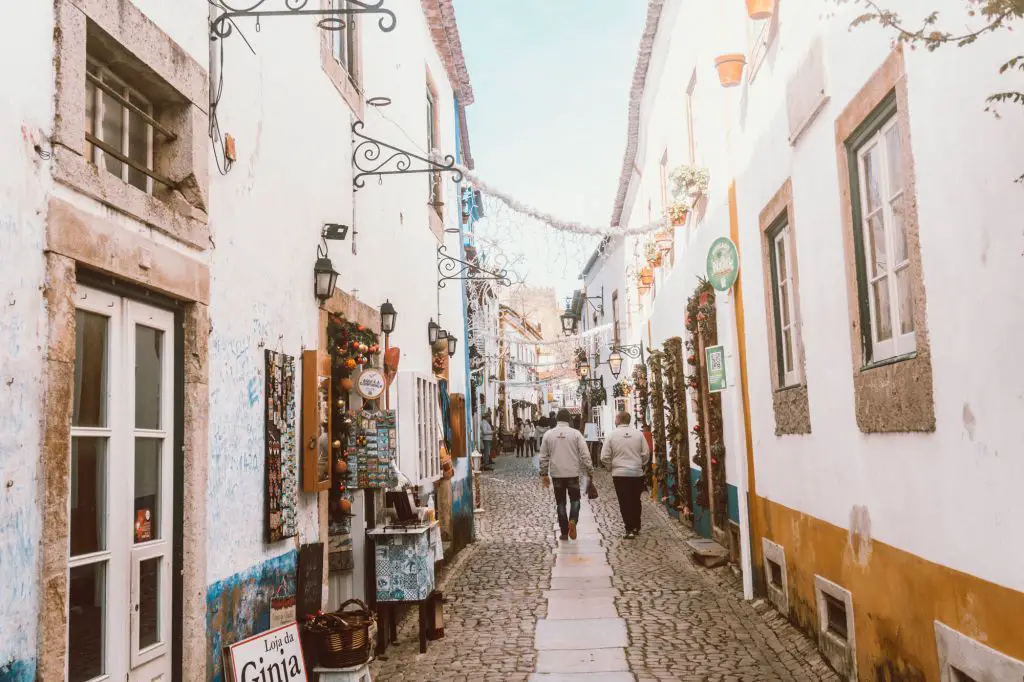
The entire city is enclosed by medieval walls that are still in great condition. This wall is 1.5km around and stands almost 15 meters high. I highly recommend walking these walls which gives you stunning views of the medieval city from its rooftops.

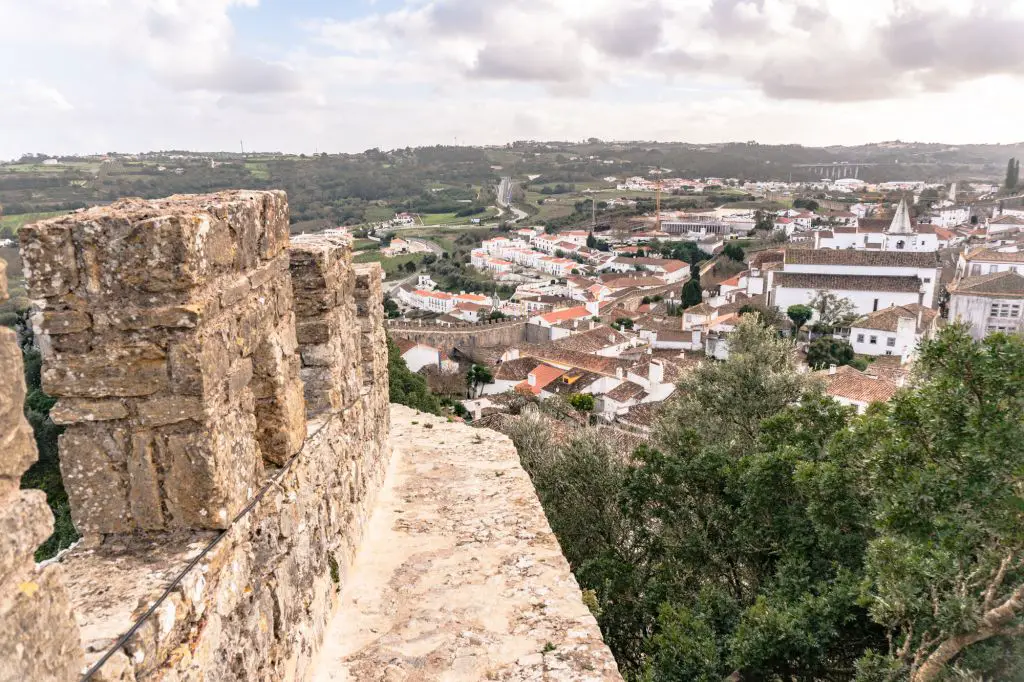
Make sure to also try the local liqueur called Ginginha. You’ll see this fruit liqueur sold at almost every corner of the town. Try it in its traditional form inside a layer of chocolate.
Day 8-11: Lisbon area
From Obidos, the next stop is finally to the capital city of Lisbon. If you would to optimize your time, I would visit Sintra, home to probably the most visually unique castle I’ve ever seen before arriving in Lisbon. Sintra is located north of Lisbon but would be on the way if you were driving from Obidos to Lisbon. More details on Sintra in the next seciton.
Like all European cities, Lisbon oozes with history (truly, you can’t turn a corner without running into a castle or a UNESCO World Heritage Site), but it’s also been home to a meaningful renaissance as of late, with flocks of young creatives taking advantage of the city’s inexpensive rent and high livability factor. The result is a celebration of Portugal’s unique culture both in real time, and with respect to the countless monarchies and armies that ruled the city in centuries past, all in a locale that’s a stone’s throw from both seaside resorts and wineries that are considered some of Europe’s best.
Walk the streets of Lisbon
Lisbon is the biggest city in Portugal. It is a beautiful mix of old and new. While not as beautiful as say Porto in the north, it has its charms in its own way that I very much enjoyed. The streets are beautiful and you can easily get lost in its unique history.

Lisbon, and Portugal as a whole are famous for its mosaic tiles, otherwise known as azulejos. You will see them dotting the facade of many buildings. Most buildings have the same azulejo tiles on the whole building while a few paint a picture (these are cool).
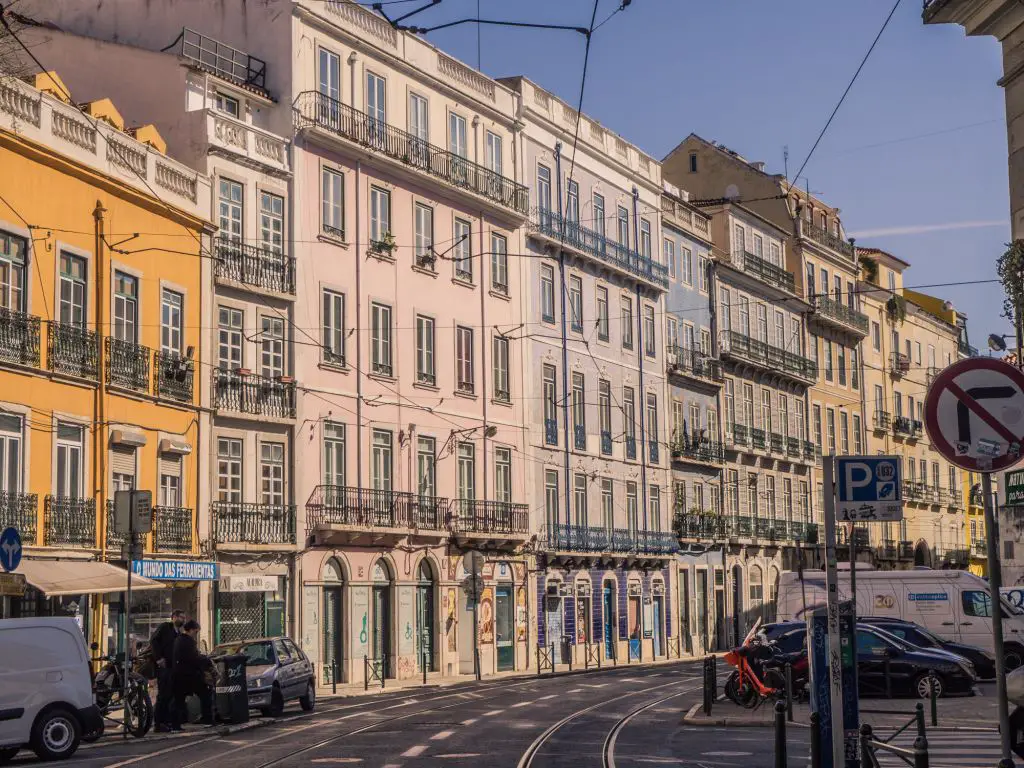
These tiles date back to the days of the Moors in 13th century but did not take off fully until the 16th century. Not only are they beautiful to look at, but they also help regulate the heat of the buildings during the hot summer months. These detailed art pieces have become incredibly valuable and have are now commonly stolen and resold on the black market. This is why you’ll see plenty of buildings with chunks of tile missing.
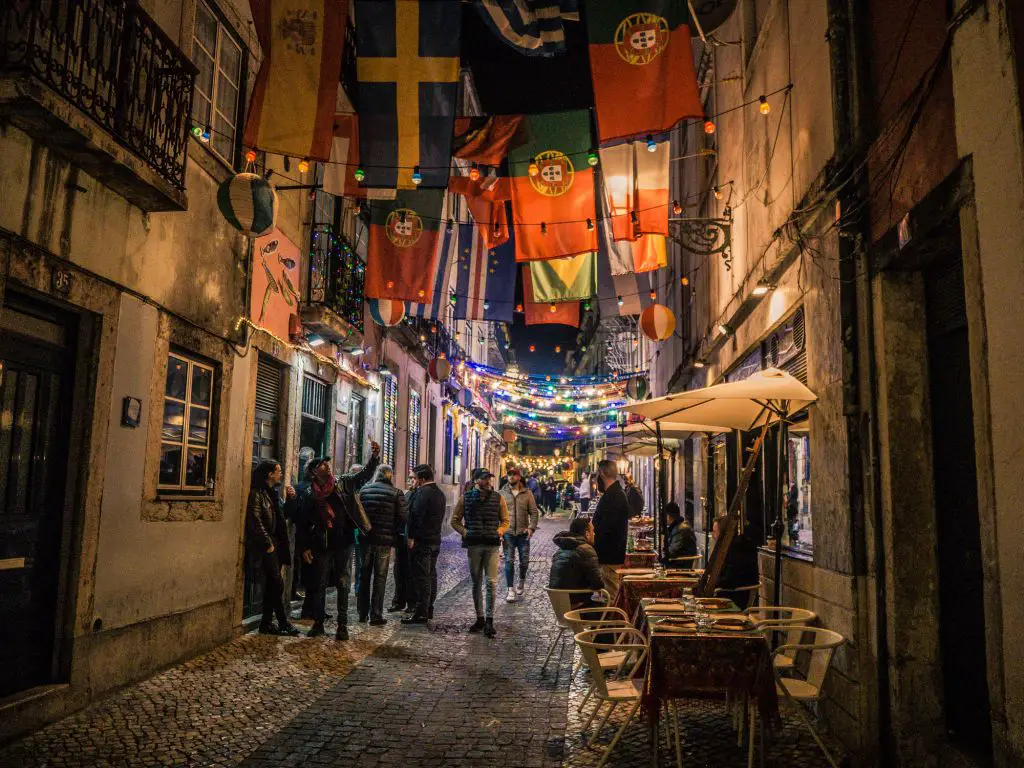
Tram 28 to Alfama – must-do in Lisbon!
One of the most iconic things about Lisbon is the yellow trams that ride above ground. These old school trams date back to the 1930s and are the basis of the trams in San Francisco. In fact, much of the cities are similar as San Francisco is also built on hills.

A single ticket to the tram costs €3 which is a steep price to pay for such a short train ride. However, this has become more of a tourist attraction than a viable mode of transport.
Barrio Alto and Chiado neighborhoods
I definitely spent most of my time hanging out in the picturesque parts of Barrio Alto and Chiado. During the day, cobblestone streets, bohemian cafes, and picturesque trams make it a wonderful place to walk around. At night, vibrant bars and delicious restaurants take over showcasing the gauntlet of Lisbon life. These are the central neighborhoods of Lisbon so you’ll see all the crowds here at night, but it is peaceful and quiet during the day.

We spent a lot of time walking through these neighborhoods on the walking tour learning about the history. These neighborhoods were once the areas for the poor but of course have since changed into the neighborhoods that all the tourists want to stay in with Airbnb.
Praça do Comércio
One of the most important and therefore most visited places in Lisbon is the Praça do Comércio , which is 170 × 170 meters in size. This central square is right on the banks of the Tejo, where you can experience a beautiful sunset in the evening.

The imposing triumphal arch Arco da Rua Augusta takes you directly to the promenade and some of the city’s important sights. The old royal palace used to stand on the Praça do Comércio, but it was destroyed by the earthquake in 1755. Today it is a tourist magnet all day long and, in addition to numerous cafés and restaurants, offers a colorful hustle and bustle.
Alfama district
Cobblestone streets, narrow streets, old houses, hills and popular landmarks. The Alfama district is home to some important historical buildings in its tight bustle, such as the Se Cathedral, the Castelo de São Jorge, the Panteão Nacional and the Igreja de Santo António. Alfama was spared the earthquake at that time, probably due to its location on the hills. As a result, the construction of the houses and the labyrinth-like streets are still reminiscent of old Lisbon.

Visit Belem
A short trip from Lisbon, the Tower of Belem was being built as part of a series of fortifications designed to protect the natural port of Lisbon. Inspired by the return of intrepid Portuguese Explorer, Vasco de Gama from the East, it includes beautiful elements of design from Venice, Morocco, and even India. To get to Belem you can take a train from the Cais dos Sodre station, or take electric tram number 15.

Another popular attraction in Belem is the Belem Tower. The Belem Tower ( Torre de Belem ) was originally built on the banks of the Tagus River to greet incoming ships. It was built in 1521 when Portugal was one of the world’s leading maritime powers. The tower is 35 meters high and sits enthroned on the bank next to the Mosteiro dos Jerónimos monastery. Just like the monastery, it also survived the earthquake of 1755 and was declared a UNESCO World Heritage Site. The tower is one of the landmarks of the city and can also be visited. In summer the tower is open from 10 a.m. to 6.30 p.m. and in winter until 5.30 p.m.
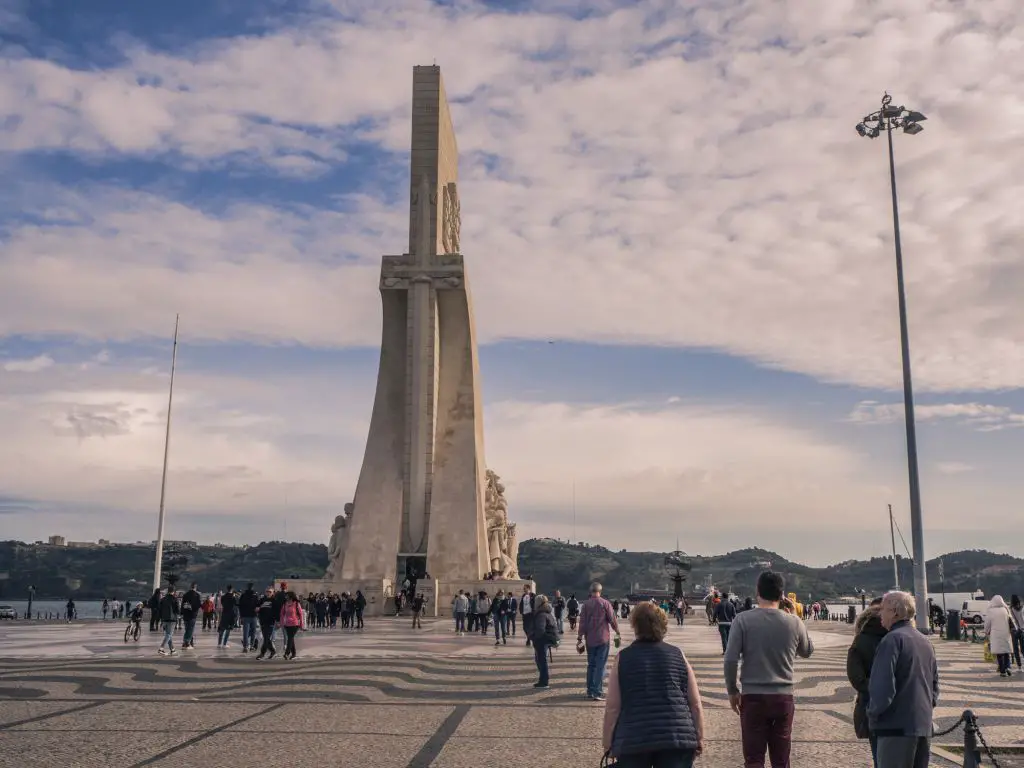
Admission: € 6 per person.
Elevador de Santa Justa
In the middle of the city center of Lisbon, very close to the Rossio square, there is another attraction that you should definitely see. Surely you have already seen the famous Elevador de Santa Justa in photos. This technological marvel has been transporting people from the Baixa district to Largo do Carmo since the 19th century. You can climb 45 meters in altitude with the elevator and enjoy a great view of the city from the platform above.
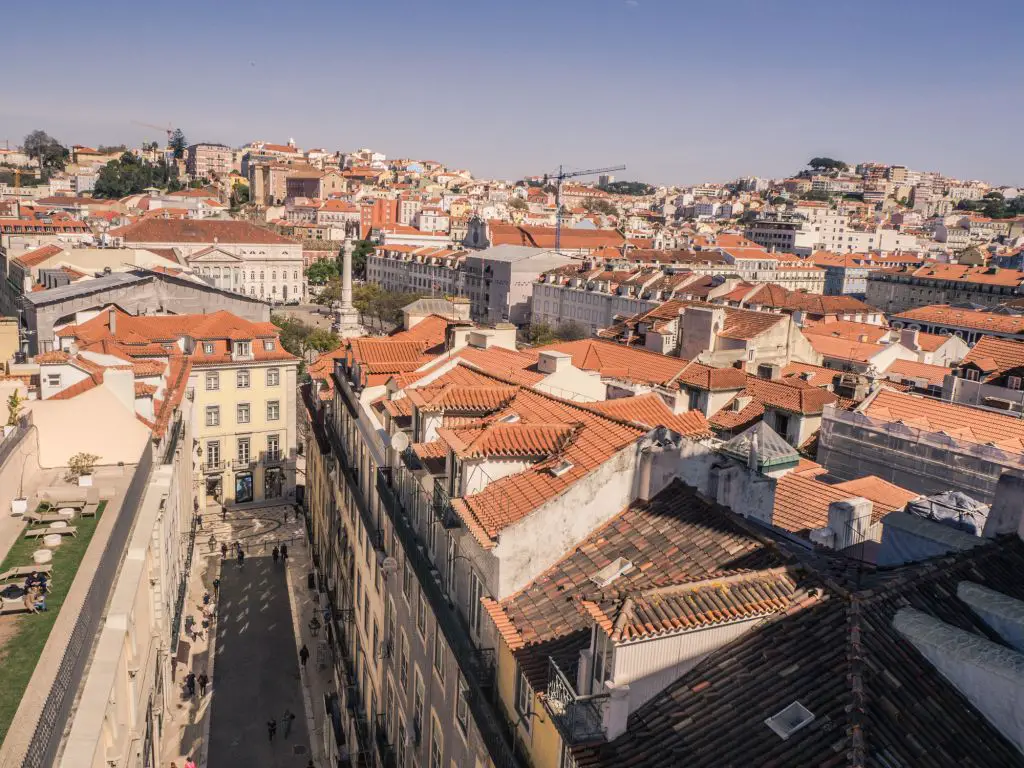
The elevator is open daily from 7:30 a.m. to 11 p.m., in winter only until 9 p.m. The trip up and down costs around € 5. With the ticket you can also go to the viewing platform. If you just want to enjoy the view but don’t want to use the elevator, you only pay € 1.50.
Free walking tour of Lisbon
When in doubt, always go for the free walking tour. There are multiple companies that do this tour every day from the plaza de la Independencia. In summer months, they run them multiple times a day as it’s become so popular.
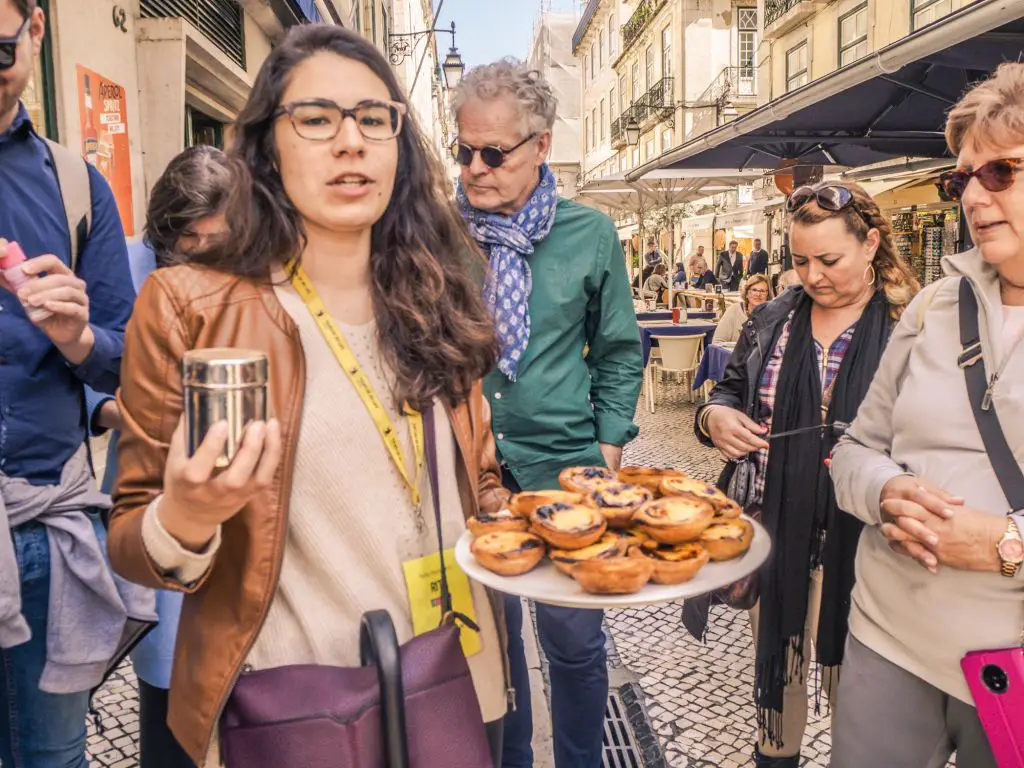
This tour will visit many of the highlighted sights that I’ve talked about already!
Miradouros (Viewpoints of Lisbon)
Lisbon is also called the city of the seven hills, which means that on a walk through the city you will pass some wonderful viewpoints, the so-called “Miradouros” . Mostly these are decorated with the typical Portuguese tiles. My three favorite places for a view over the city are the Miradouro da Graça, the view from the Miradouro de Santa Luzia and of course the view from the Castelo de São Jorge. You will find many viewpoints by chance if you drift through the city.
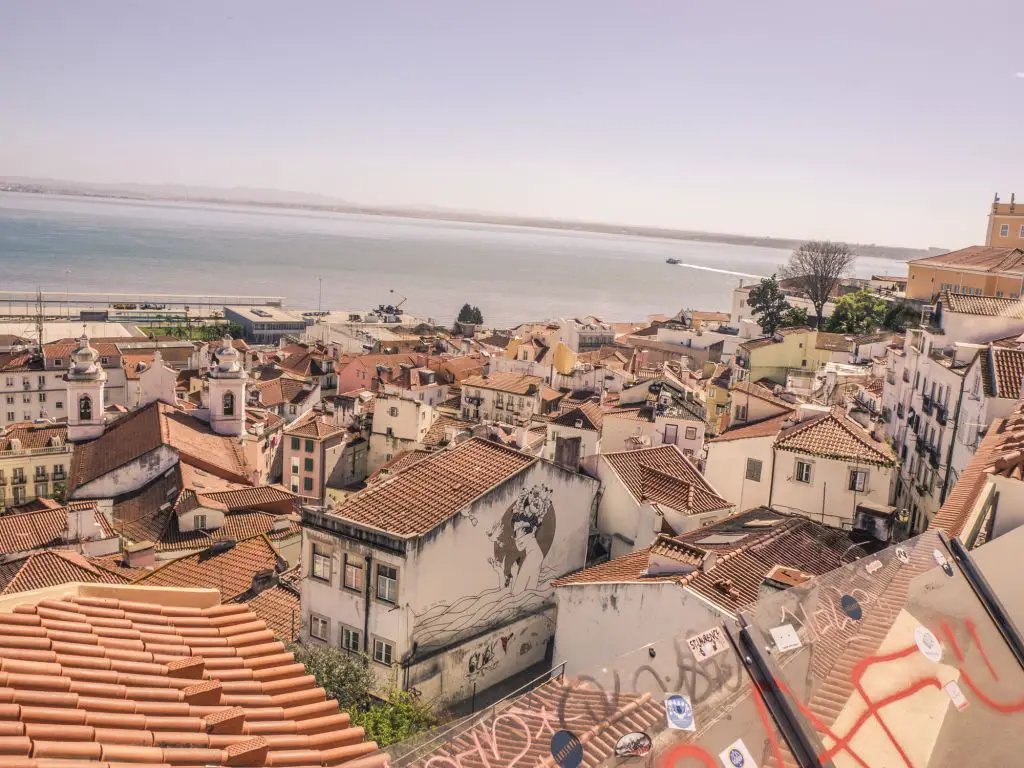
Visit Sintra Castle for the day
If you’re in Lisbon for a few days and want to do something outside of the city, look no further than the Sintra Castle. Located just 30 minutes from Lisbon, it is an easy trip to make for a half day. The castle itself is huge and sits at the top of a hill. It’s immaculately decorated that it almost looks fake when you first see it.

Explore Sintra Castle
For those who love a good castle, they don’t come much better than Sintra. Set in the greater region of Lisbon, Sintra rises up like a colourful dream from fairytale mountains and forest mists. Located to the North of Lisbon city, and a former royal sanctuary, Sintra is a resort town in the Sintra foothills. There’s more than one palace in Sintra – the most famous (and colourful) is the Pena Palace.
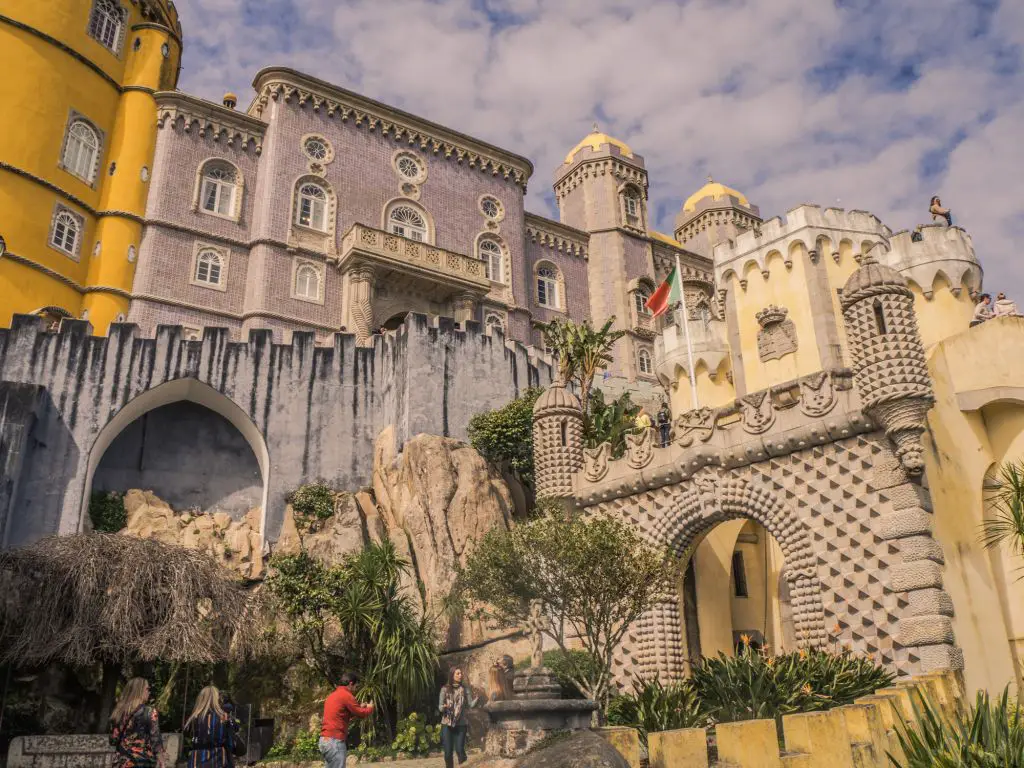

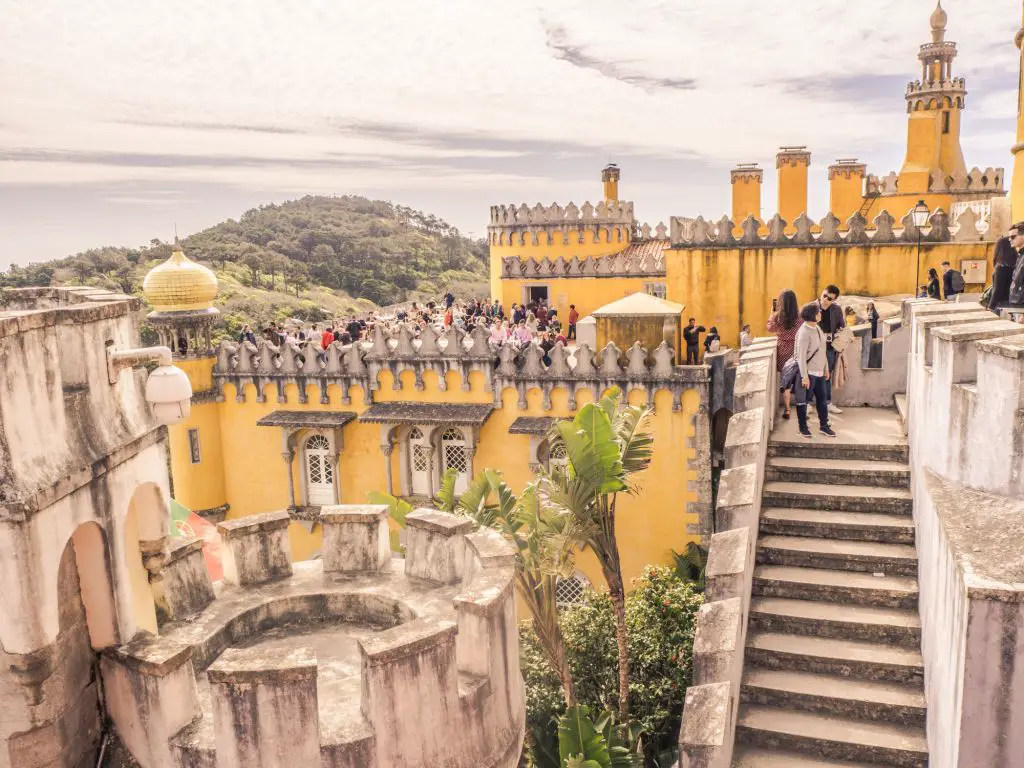

Although Sintra is easily accessible from Lisbon by train or bus, to get the full Sintra experience it is better to spend a night in Sintra – that way you can get up early and have the palaces to yourself before the coach tours and day-trippers arrive!
Get to Sintra from Lisbon
Getting from Lisbon to Sintra. Getting to Sintra from Lisbon is easy. There are trains at least every 30 minutes on weekdays, every 30 minutes at weekends, from Lisbon’s city centre Rossio station. The journey takes 39 minutes and a return (round-trip) ticket is €4.30 (tariff 2016). From the Sintra train station, there are buses that regular go to the castle.
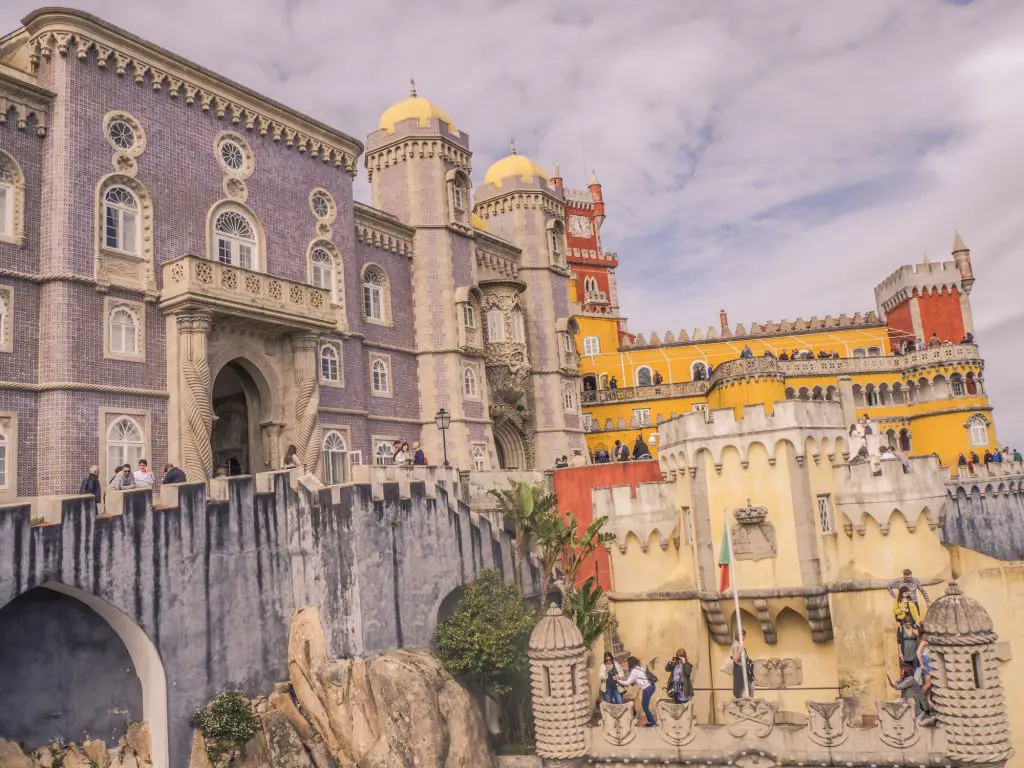
The 434-tourist bus provides an invaluable service as it connects the train station, to the Palácio da Pena and passes the historic centre and the Castelo dos Mouros. Without the bus, it is a 20-minute walk from Sintra train station to the historic centre, or a very demanding 45minute uphill hike to the Castelo dos Mouros and Palácio da Pena. A hop-on-hop-off bus ticket for the 434 bus route costs €6.90 or a single is €3.90, and there is a departure every 15 minutes during the peak season.
Alternatively, you can take a tuk-tuk to the top of the palacio. These tuktuks are everywhere in Sintra and there doesn’t seem to be a set price as you just negotiate. I actually took the tuktuk from the palace down to the city square for €5 pp. I think I remember them saying it is €5-10 per person for a ride which is absolutely insane considering it is no more than a 2km ride. In fact, you can actually just take an Uber from the Sintra train station to the Palacio for less than €5 total!
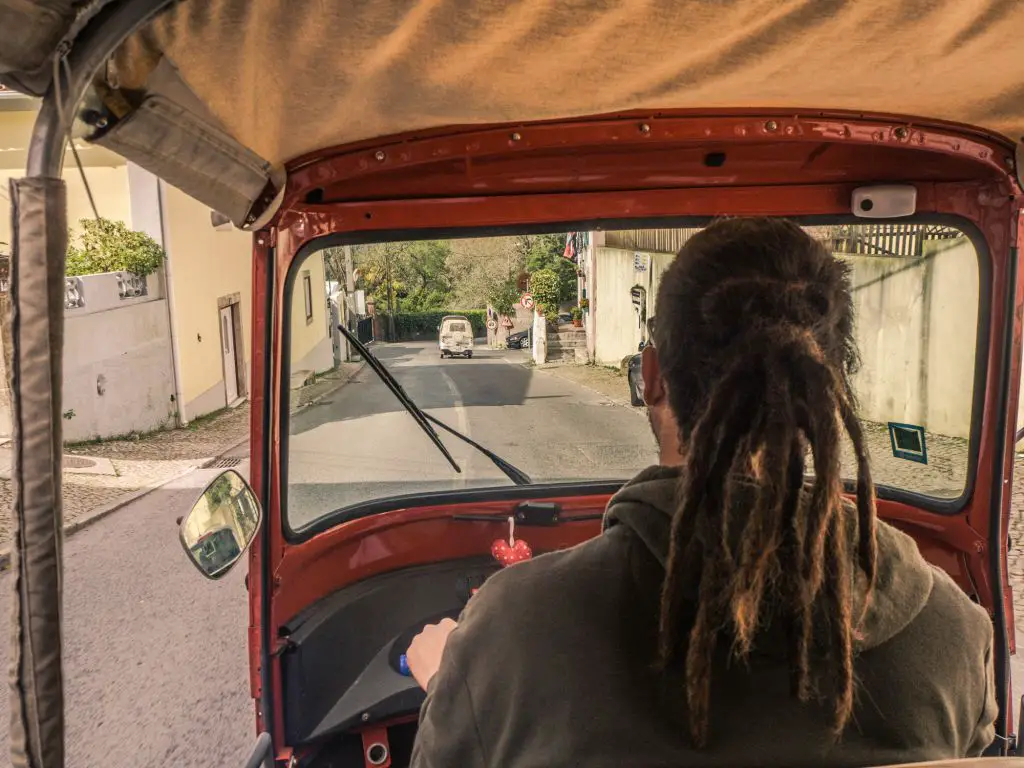
Alternatively, if you don’t want to get to the train station or be on its schedule, Uber is also a cost effective way to see the castle. From Lisbon, I took an Uber which was around €20 but this dropped me off right at the entrance to the castle. It probably saved me almost 1 hour or so to do this. If you are two or more people, then this is the best method.
Visiting the Palacio Nacional Da Pena
The Palácio Nacional da Pena is considered as one of the finest palaces in Europe, and will be the highlight of any day trip to Sintra.
The vivid colours of the palace are in stark contrast to the lush forest which surrounds it, while decorative stone carvings line the terraces. The interior of the Palácio da Pena is as equally fascinating, being restored to how it appeared in 1910, when the monarchy was forced to fee Portugal due to a revolution.
The price of entry for this palace is €14.00 and allows entry to the staterooms, the terraces and the Parque da Pena. It’s a bit on the pricey end but you already made it this far so why not?
You should also consider buying the tickets online as the lines will be very busy in the summer months. With a mobile ticket, you don’t need to queue to buy your ticket thereby saving you considerable time.
Day 12: Drive down the southwest Coast of Portugal
The next day is dedicated to a road trip along the Atlantic coast of Southern Portugal. From Lisbon, you can either drive to Setubal or Sesimbra to start off the day and even stay in these towns for a night or two. I figured as I was already spending time in the Algarve, I did not need to spent more time at other coastal towns.
The beaches in Setubal are considered some of the best in Portugal but I found the beaches in the Algarve to be more pretty. The stretch between Sines and Sagres is considered the Alentejo coast and is well worth the drive and visit.
The drive itself is actually not so picturesque. It’s not like Chapman’s Peak in Cape Town where the road hugs the cliff edge offering you nonstop stunning views. Most of the drive is through forest as the road is inland. You’ll have to drive from the main road towards the beach to see the beautiful sights. Here are a list of the towns I stopped in.
Arrifana
Arrifana is a popular surf town with a great viewpoint and beach. There is also a fabulous restaurant here called O Paulo which is a perfect place to eat lunch or watch the sunset. The views are simply amazing. I spent the night here so to break up the drive between Lisbon and the Algarve. From Arrifana, it is less than one hour from Lagos but I figured this is a nice spot to relax and watch the sunset.
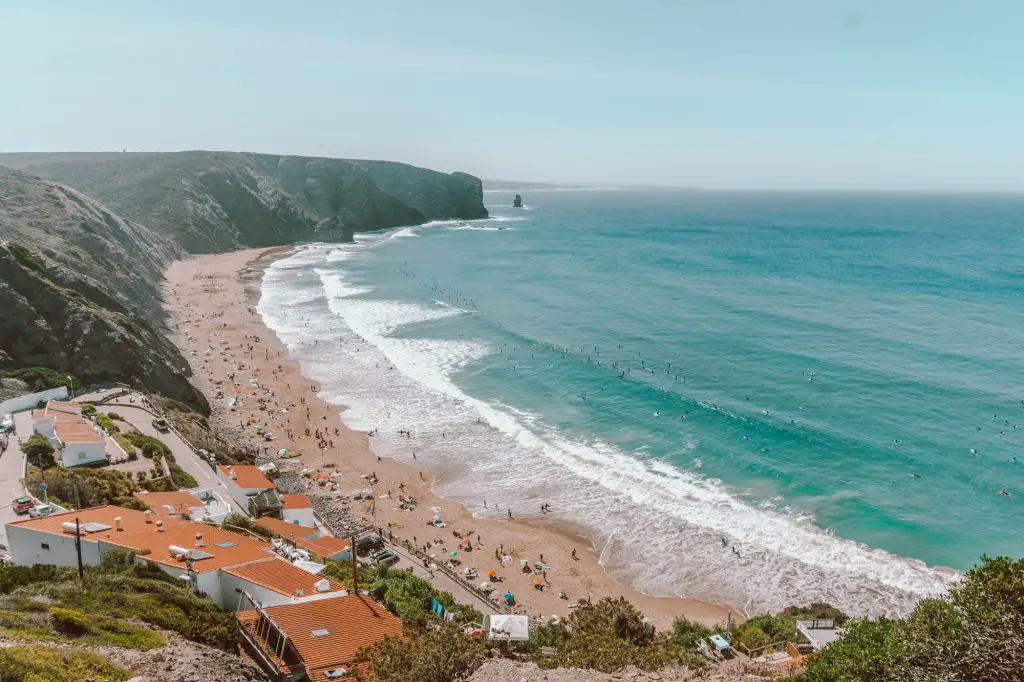
Praia Amoreira
Praia Amoreira is located just north of Arrifana and is home to a big sandy beach surrounded by cliffs.
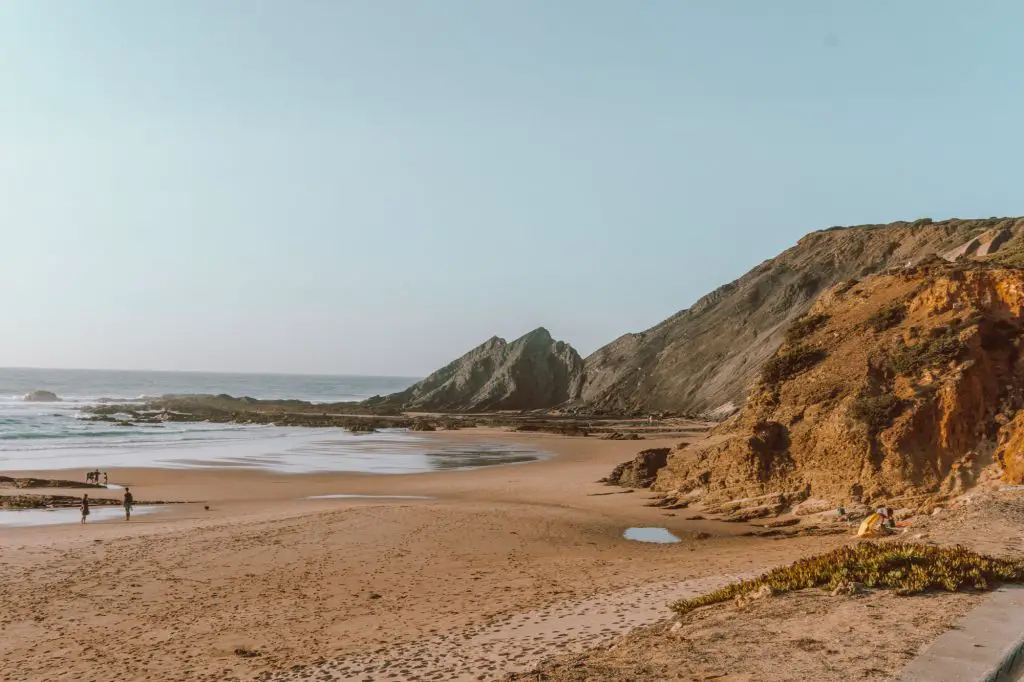
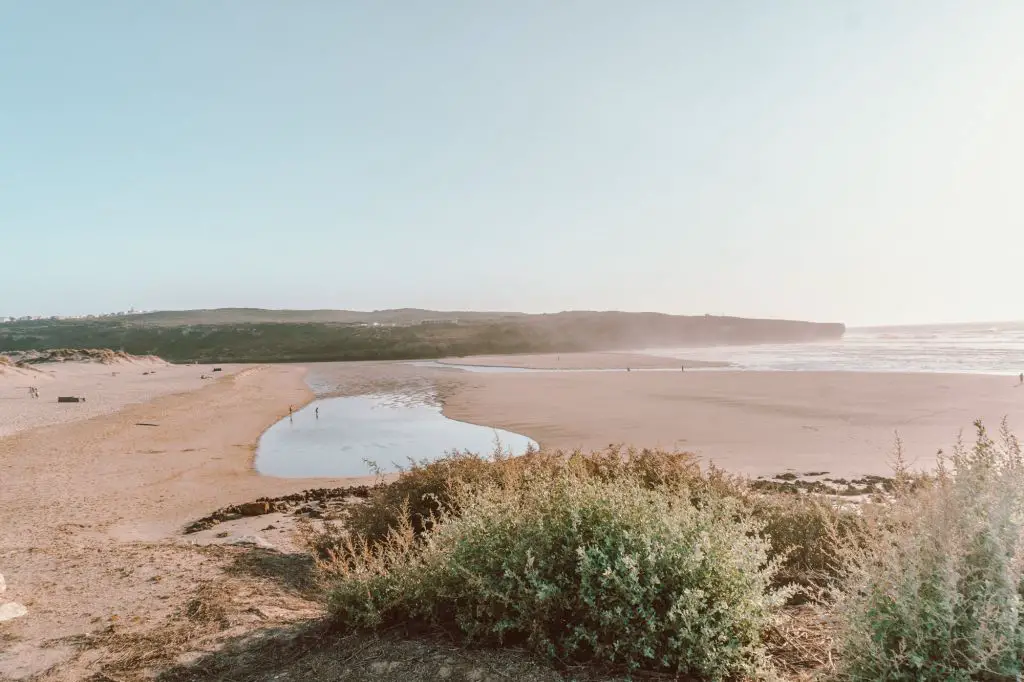

Azenha Do Mar Lunch stop
Further north is the town of Azenha Do Mar. I stopped here for lunch at the famous Azenha Do Mar seafood restaurant. This local style Portuguese restaurant serves delicious seafood at reasonable prices and has a terrace with stunning views of the Atlantic.
I had the seafood rice which is a typical Portuguese seafood dish and it was absolutely divine.
Make sure to reserve ahead of time for this place as it gets quite busy.
Zambujeira do Mar
Zambujeira do Mar is another typical coastal city on Portugal’s western coastline. I didn’t actually stop in this town but rather stopped to take some beautiful photos of the beach and town.


Vila Nova de Milfontes
Vila Nova de Milfontes is one of the most popular towns in the Alentejo coast. It is home to beautiful beaches and white washed buildings in the town.
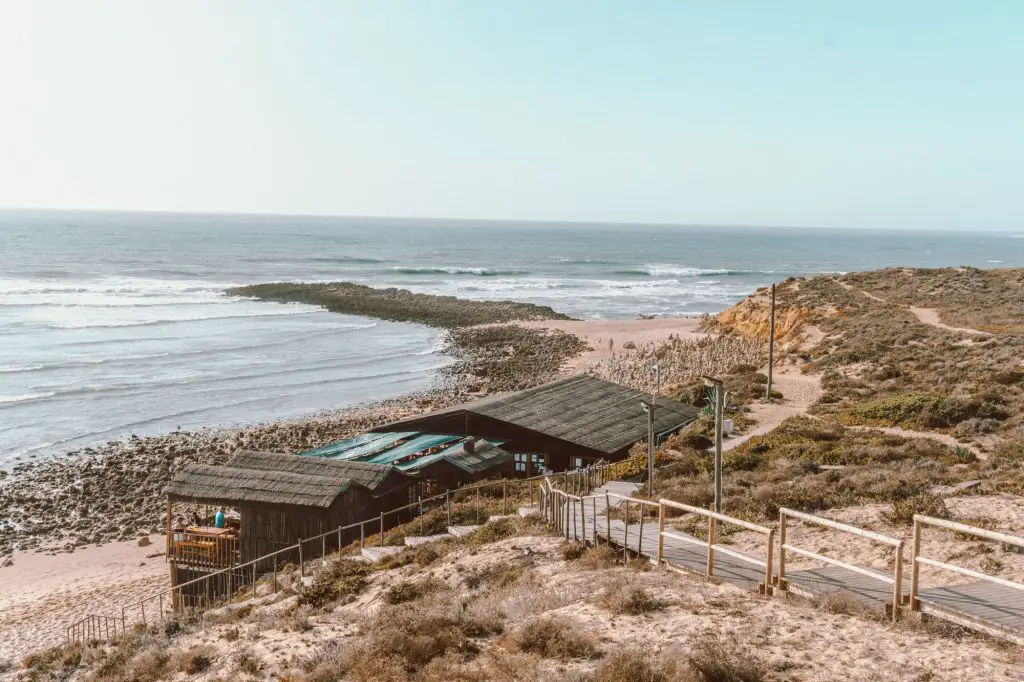

Porto Covo
Porto Covo is a traditional fishing village north of Vila Nova de Milfontes and has stunning beaches. This is also a popular starting point for numerous hiking trails that hug the Alentejo coast.
Day 13-15: Sagres and Lagos
The next day I moved locations to the town of Lagos. This is only 30 minutes driving from Carvoeiro but I just wanted a change of scenery to see what all the Algarve had to offer!
Make sure to read my Algarve trip in detail if you are planning to make this part of your Portugal trip.
Sagres
First stop is Sagres, considered the furthest southwestern point on Continental Europe. It’s home to a vibrant surf community and is also the base for numerous hiking trails.
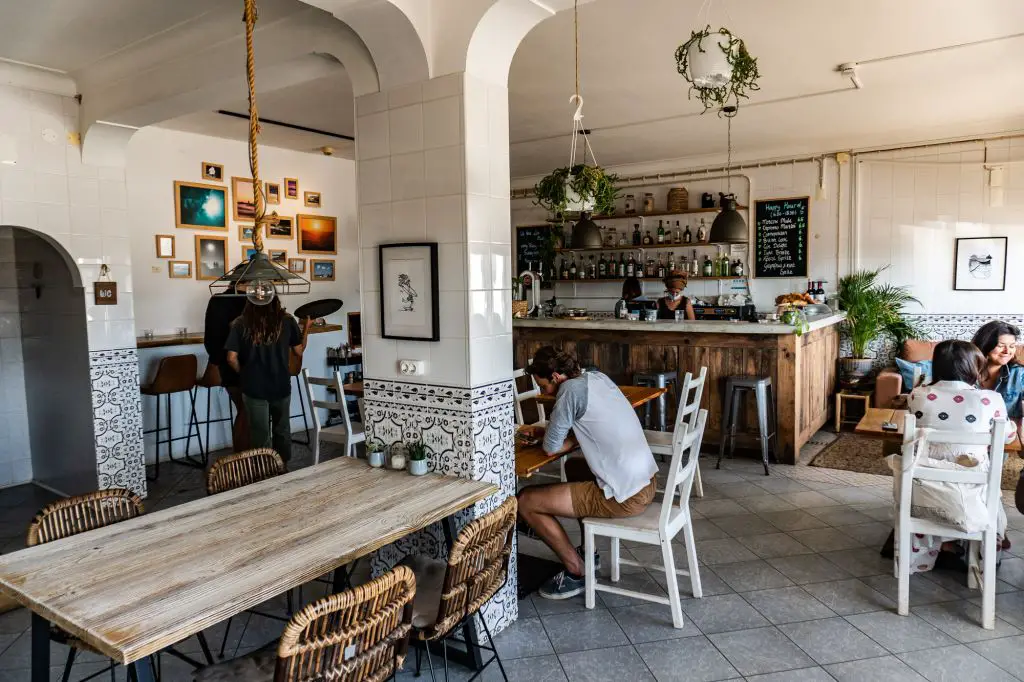

There is not much to see in Sagres except for the famous Sagres Fortress. This fortress is a huge structure and was constructed in the 15th century as a way to fend off invaders from North Africa.

It offers stunning views of the peninsula and the bluffs surrounding the structure. There is also a lighthouse at the very tip of the peninsula which you can walk to from the fortress.

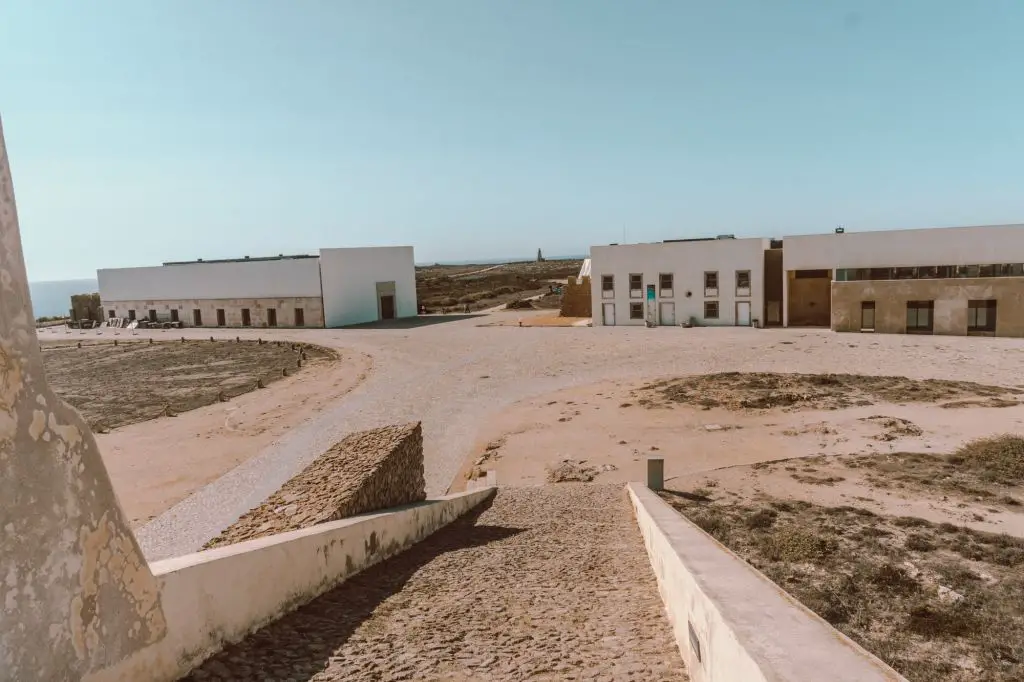
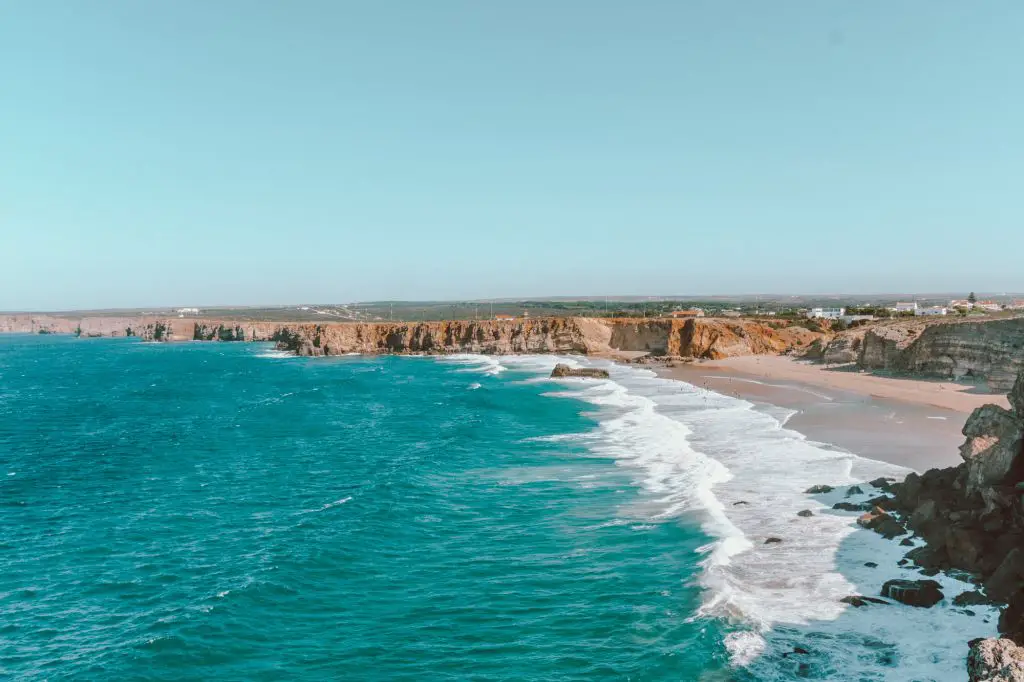
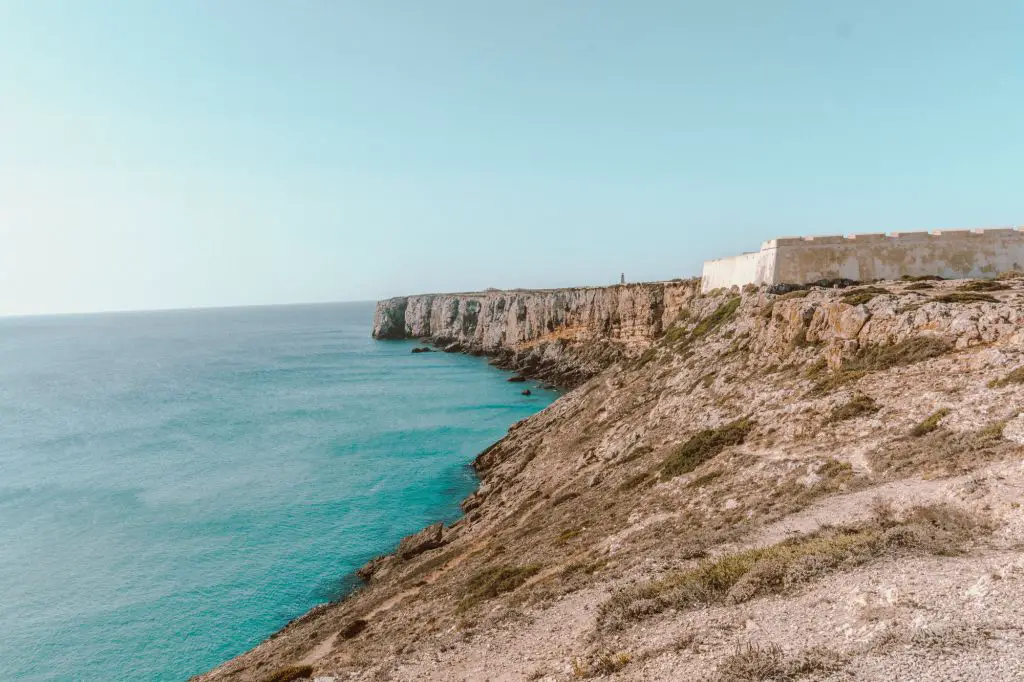
I also stopped here for breakfast at the Laundry Lounge Cafe. This beautiful hipster style cafe actually does your laundry while you eat their delicious food.
Lagos Town
Lagos is the second largest city in the Algarve after Faro. It is a very popular base for travelers coming through the Algarve as it is close to all the sights, has an abundance of restaurants and nightlife, as well as plenty of great accommodation options.

Its history is long and expansive as well dating back to the time of the Ancient Phoenicians. Lagos took control over the African trade and became the most important town in the Algarve and its capital between 1576 and 1756. The town was greatly destroyed by the terrible earthquake of 1755. As a result, the capital from the Algarve changed from Lagos to Faro.

Lagos has a beautiful old town that I found to be prettier than say Albufeira (but of course not as charming as Ferragudo or Silves). At night Lagos can be quite loud and the heart of the party so keep that in mind if you are noise sensitive.
There isn’t a whole lot to see as far as sights in Lagos. Its old city surrounded by the old walls is pretty to look at but in the end, the Algarve is all about the natural scenery. Once you’re done exploring the town, simply walk (or drive) south towards the beautiful viewpoints and beach.
There are plenty of amazing bars and restaurants in Lagos. Make sure to eat at the Reis restaurant to sample the famous Seafood Rice (Arroz con Marisco).
Praia Do Camilo
This is one of the most famous beaches in the Algarve. It’s located within walking distance to Lagos so if you do not have a car while visiting, this is the place for you. This small beach is enclosed by towering cliffs which makes the water calm and warm to swim in.

There is also a long windy set of stairs that lead to this beach and this makes for some fantastic photos.
Praia Das Furnas
Without a doubt, this is the best beach in the Algarve. If you like powder soft white sand, turquoise water, small crowds, and a stunning mountain backdrop, this is the beach for you.

I visited the Algarve in September and most of the beaches while beautiful, were packed full of people. If you like being with a lot of other people, then the above beaches will more than suit your fancy. However, if you are like me and like to visit the beach for just the natural beauty, aka without all the beach bars, fancy beach chairs, and the general scene, then this is the spot for you.

It’s located about 30 minutes west of Lagos and it is totally off the beaten path. When I arrived here, I knew I was in the right spot. A huge swatch of the softest powder sand I’ve ever felt was upon me. The water was crystal shallow and crystal clear. There were only a handful of people here on a Saturday in September. There were no beach chairs, and no restaurants here which is just how I like it.
One thing to note, this is a nude beach. Prepare to see naked people. If this is not your thing, the beach is plenty of big where you can get away from people. Nevertheless, this is the nicest beach I found on my Algarve trip.
Day 15-18: Carvoeiro, Ferragudo, and the surrounding beaches
Carvoeiro Town
I chose Carvoeiro Town as my base for the the Algarve for three nights. I used it as a way to explore the numerous beaches and viewpoints along the central coast of the Algarve.
I was debating between Carvoeiro and Ferragudo but ultimately decided on Carvoeiro because I found a beautiful Airbnb with great views of the town.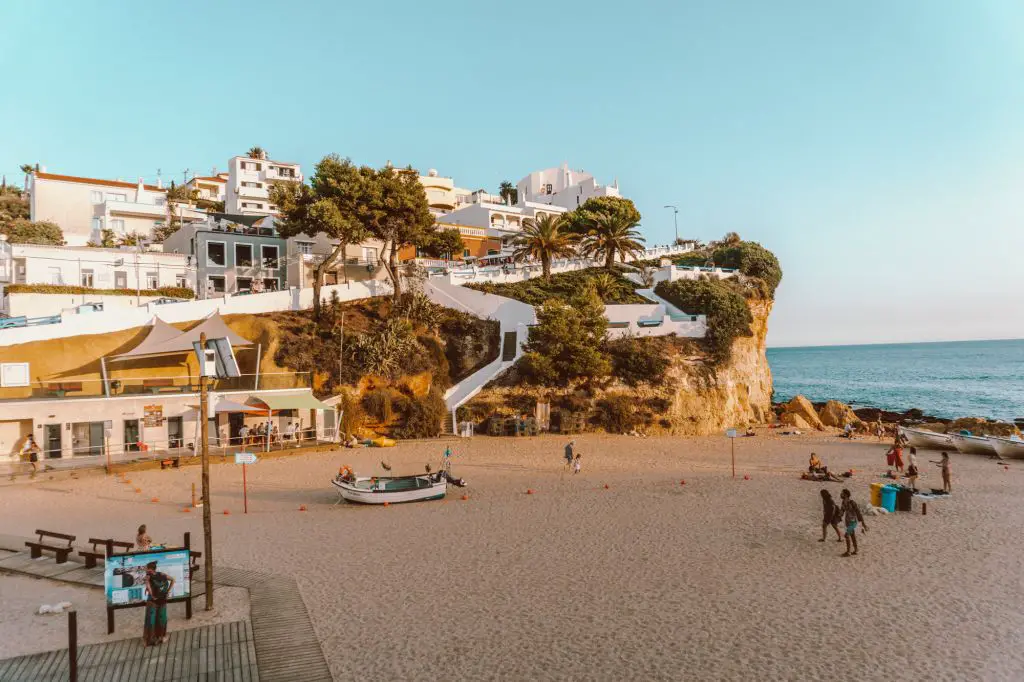
Carvoerio is a former fisherman’s village turned into a tourist destination. The town offers an abundance of restaurants and bars but with a much more lowkey feel than neighboring towns like Albufeira and Lagos.

The town is also right on the water and walking up Rampa Sra. da Encarnacao will afford you stunning views of the beach, town, and the surrounding cliffs. Carvoerio offers beautiful hiking right next door with a long boardwalk that extends for many kilometers offering stunning views of the coast.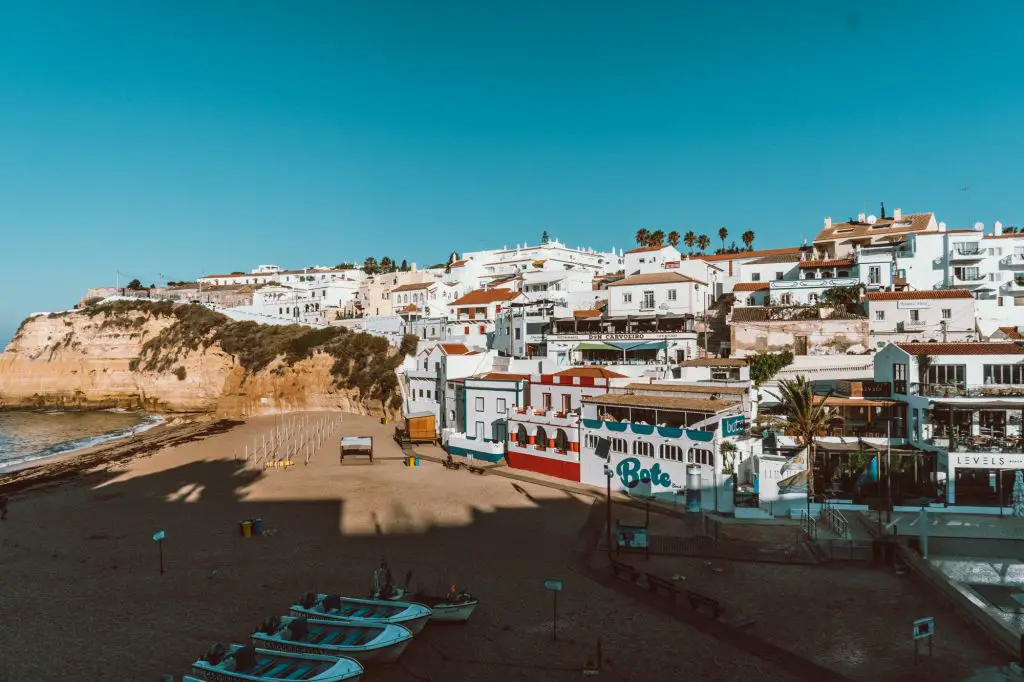
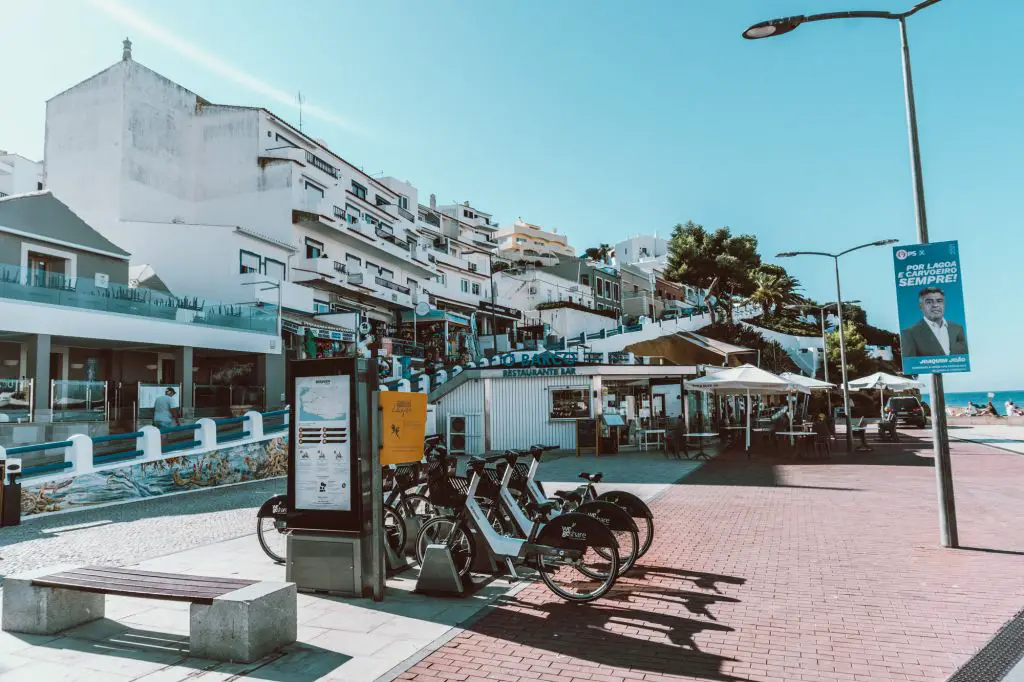
For sunset, make sure to head up to the Mar D’Fora restaurant for a quick drink while enjoying the beautiful views with its white washed stairs winding down into the sea. Even better, bring your own drinks and watch the views yourself!
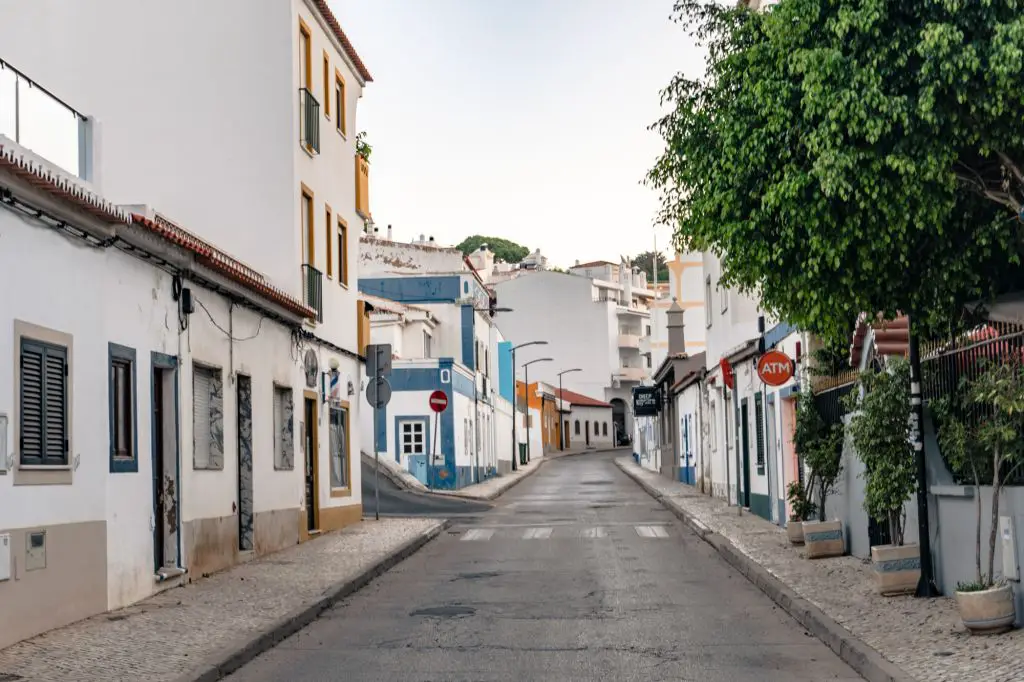

Algar Seco
Located within walking distance of Carvoeiro, Algar Seco is a rock formation that’s famous for its windows into the Algarve.

This beautiful rock formation is located near to the water and has two window like holes built into the rock that makes for stunning photos of the Atlantic. Nearby is a beautiful bar and restaurant which makes for a great drink spot.
Praia Do Marinha and Arco Natural
Praia Do Marinha is one of the most beautiful and popular beaches of the central Algarve coast. It offers a long stretch of sandy beach surrounded by dramatic cliff formations.
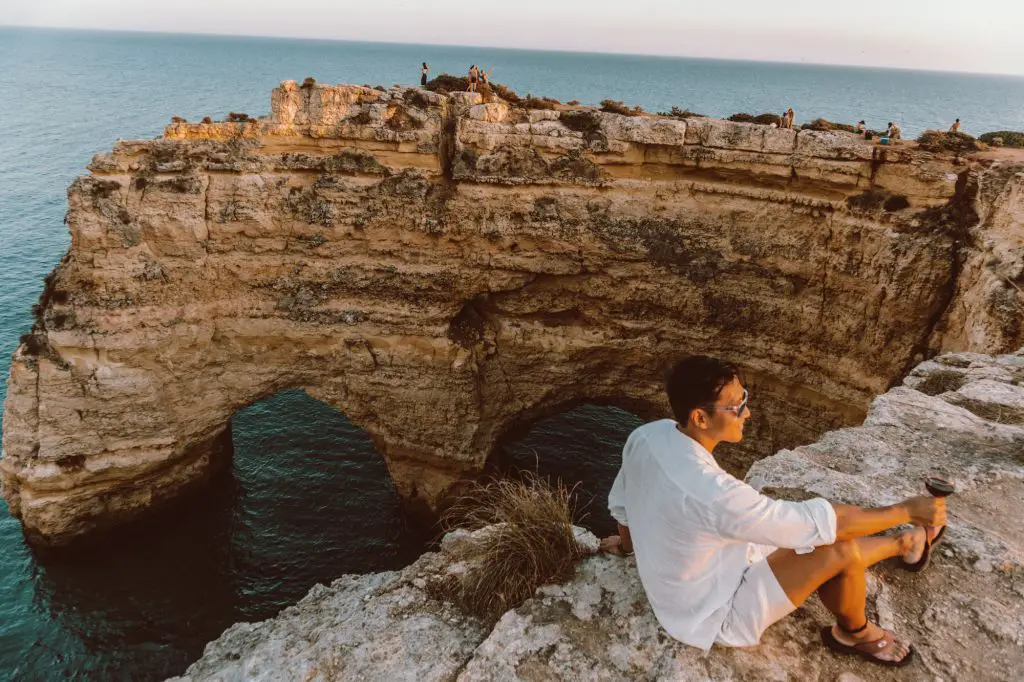
However, the star of the show is definitely the Arco Naturele located near to the beach. There is a double arch here that
Praia Do Albandeira
Praia Do Albandeira is probably my favorite beach in this area between Albufeira and Portimao. It’s a smaller beach with slightly smaller crowds.
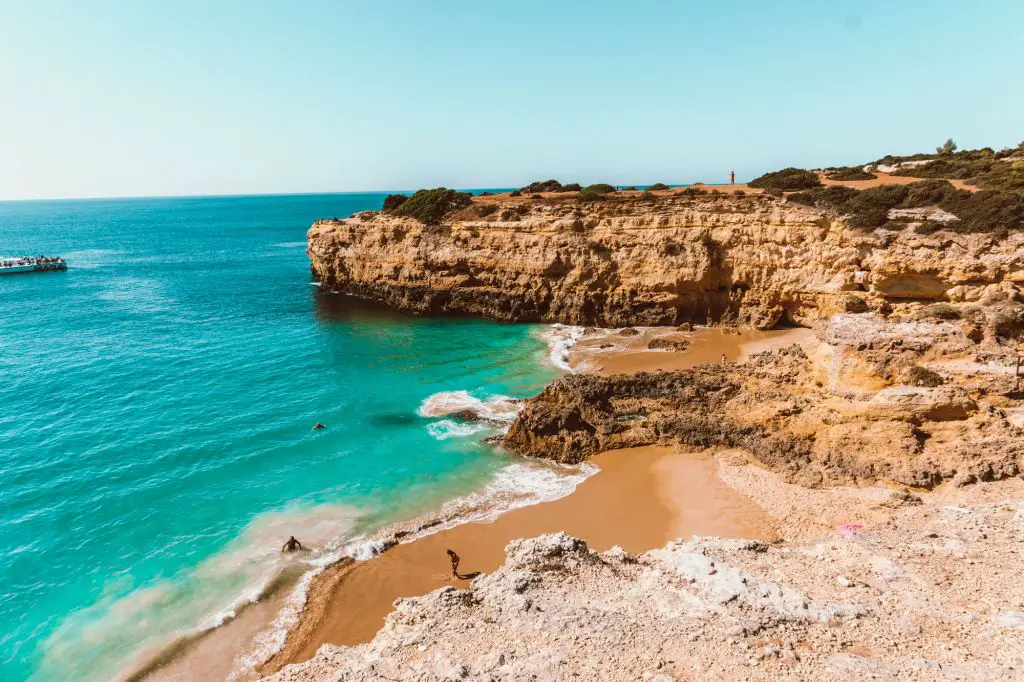

Its claim to fame is the beautiful arch. Similar to the arch at Praia Do Marinha, this arch is huge standing at over 50 meters. This is a fantastic spot for the sunset and makes for amazing photos as the colors turn.
Praia do Carvalho
Completely surrounded by high cliffs, this small beach is known for its soft, golden sand and crystal clear water. This is definitely one of the most picturesque beaches in the Algarve and well worth a visit. However, during high season, this place was absolutely packed which was a bit of a turn off to me.
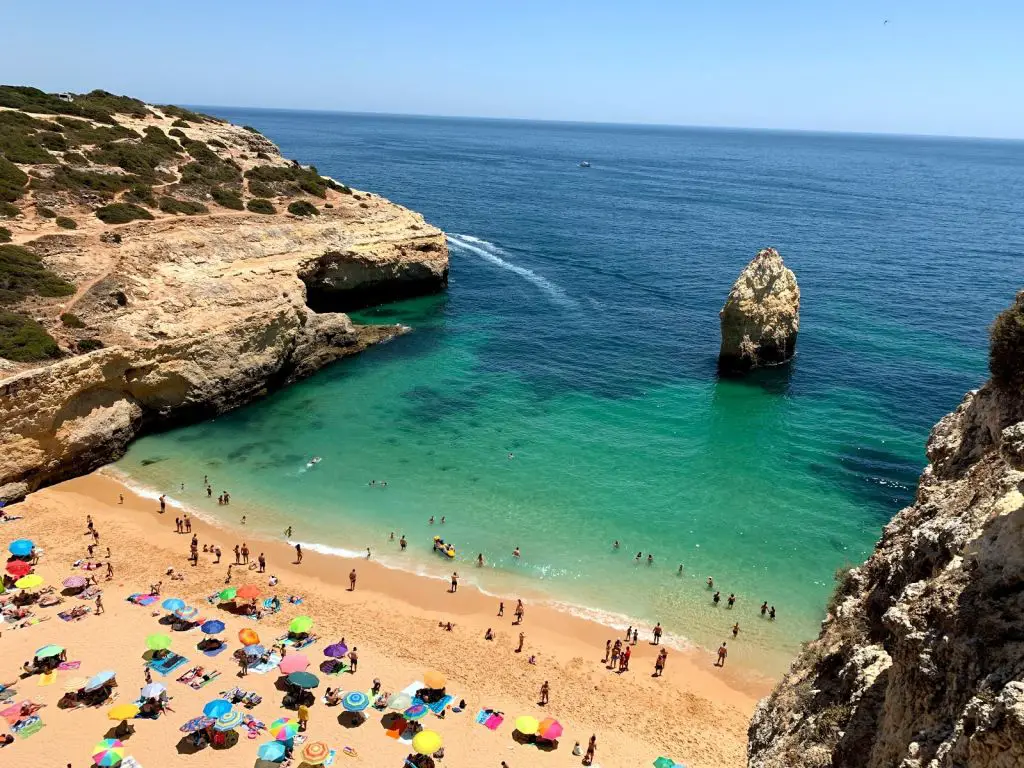
Albufeira Town
One of the most popular towns in the Algarve is Albufeira. I’d say Albufeira and Lagos are the biggest towns in the Algarve region with Albufeira being easier to access as it is closer to Faro airport. Albufeira is a pretty little town with an abundance of restaurants and bars. There is also a beach right in the city which makes it easy for those that don’t have cars. 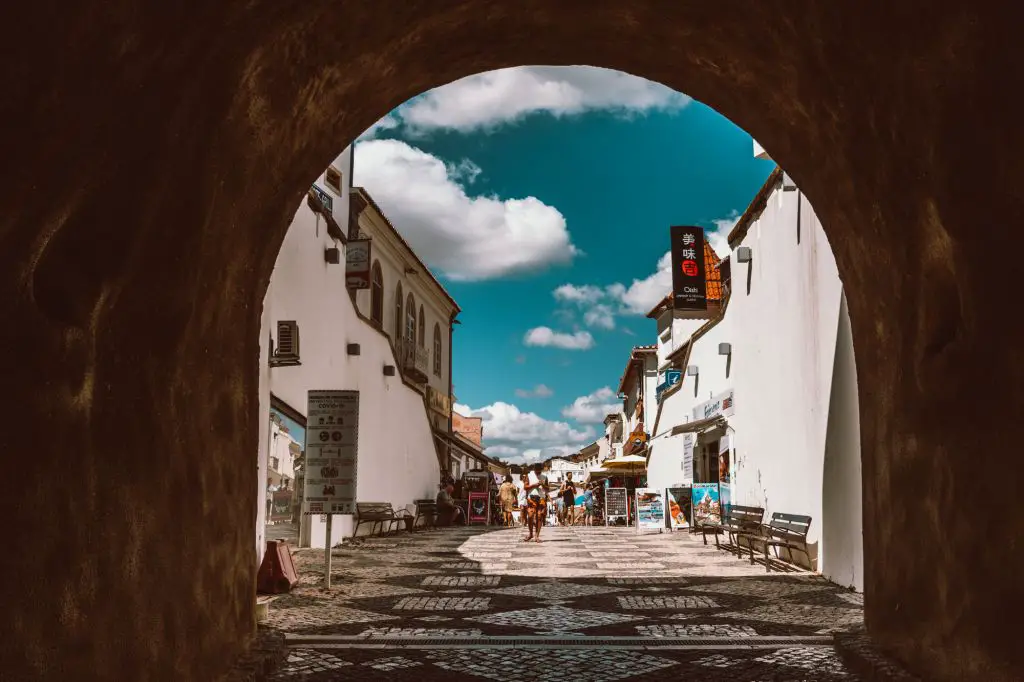
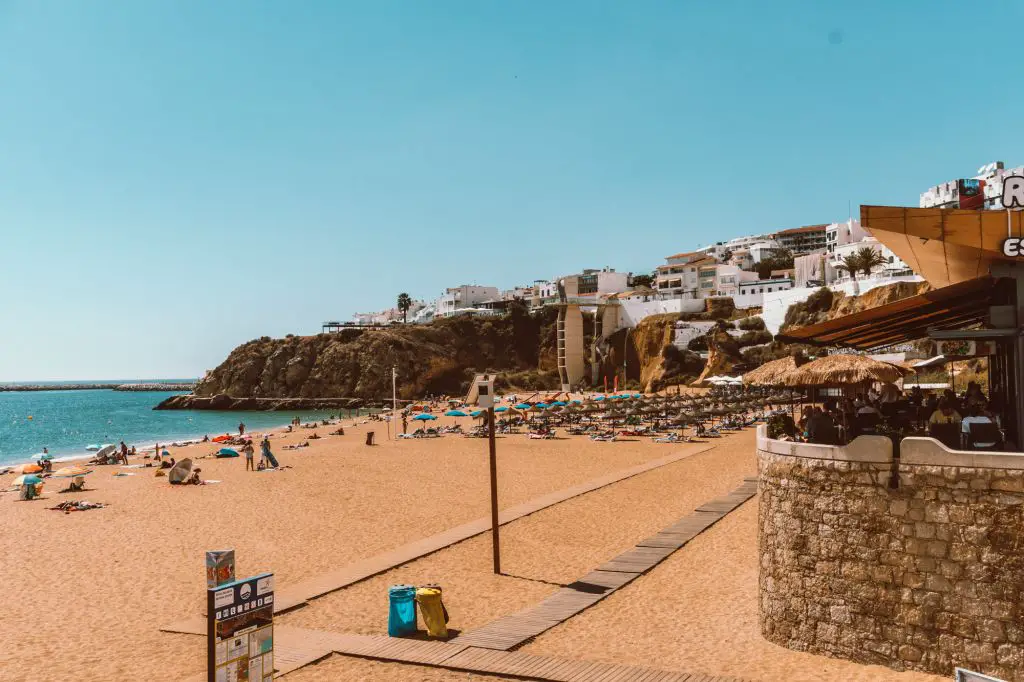
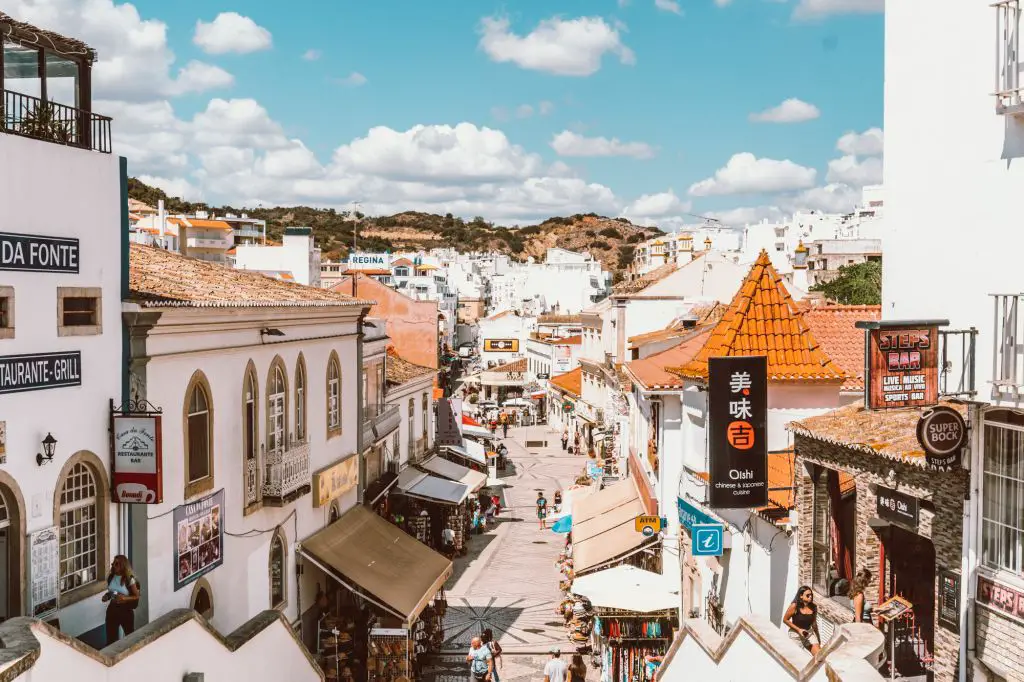
Benagil Caves
The Benagil caves are without a doubt the most popular and visited attraction in all of the Algarve. This huge cave formation is located right near the town of Benagil.
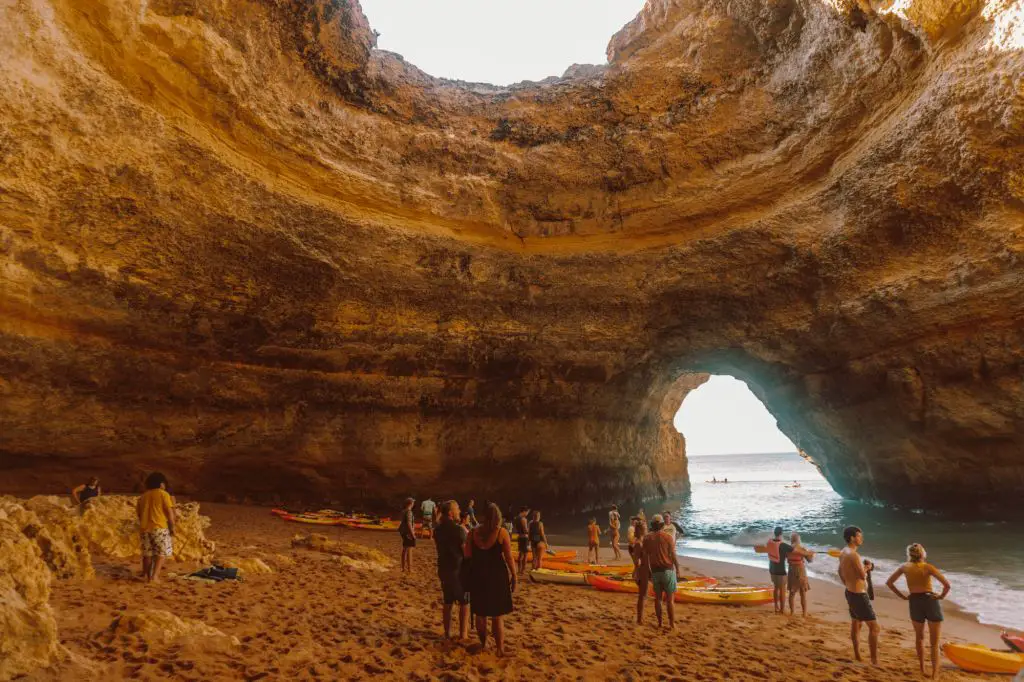
he Benagil Cave is a natural cave formation in the oceanside cliffs of Portugal’s Algarve region. Though many caves and rock formations line the coast of the Algarve, the Benagil Cave is unique for the “skylight” in the cave’s ceiling. The cave, like much of Portugal’s coastline, is made up of limestone.
It is a huge cave and definitely one of the most visually stunning caves I’ve ever visited. To reach the caves, you will want to either do one of the following:
- Take a boat tour from Lagos, Albufeira, Carvoeiro, Portimao, or pretty much anywhere. This is one of the most popular tours in the Algarve
- Rent a kayak or SUP from the nearby Benagil beach and paddle roughly 10 minutes to the cave adjacent.
- Swim from the beach to the cave (about 100 meters)
I rented a Kayak which is quite expensive especially for little time you spend on it. In total, I paid 15 euros per person for a two person kayak boat (that’s all they have). If you’re two people, expect to pay 30 euros for a 2h kayak rental! It is crazy expensive for what it is. SUP boards are also not much cheaper.

Swim to Benagil Caves
I couldn’t find much information on the internet about swimming to the cave. I just figured it was far away and not a great way to reach the cave. It turns out, the water is quite calm in the summer months and the distance is only 100 meters. If you are a semi-comfortable swimmer like myself who completed his divemaster, this is super easy and safe to do. I would totally just grab a dry bag and swim to the cave next time. It’s free, easy, and a good workout!
Expectations vs Reality
The cave itself is beautiful. It’s huge and stunning. The only problem is it is packed full of people. Upon arrival, there must have been at last 100 other people. This was at 9:30am no less. It’s one of those perfect expectations vs reality photos. I would not rush to do this cave again.
Silves Town
Silves is located 20km north of the coastline. It’s an absolutely beautiful town and was the ancient capital of the Algarve region. Under the Moors, Silves was a major defensive stronghold and important trading center. Nowadays, Silves is a peaceful town with a beautiful historical center that includes the imposing red break castle, the town walls, Gothic cathedral, and more.
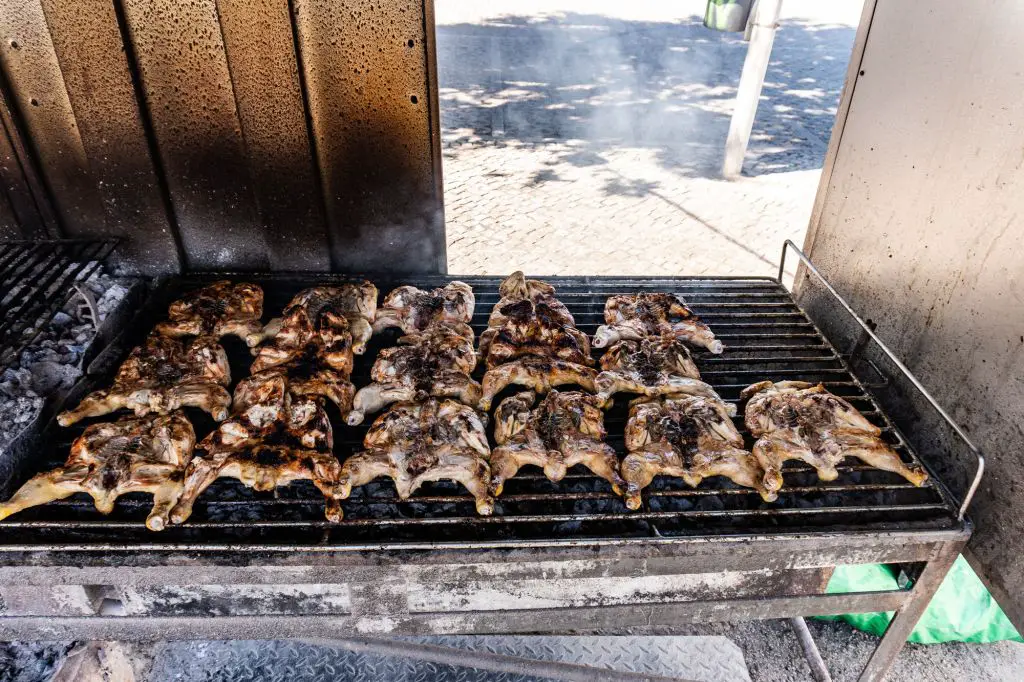
I actually did not know about Silves at all. What brought me here was my search for grilled chicken (or Frango) which is famous along the Algarve coast. I found a frango restaurant in this town that looked amazing (and it absolutely was). Upon arriving, I immediately noticed the big red castle at the top of the town and knew I had to at least walk through it.
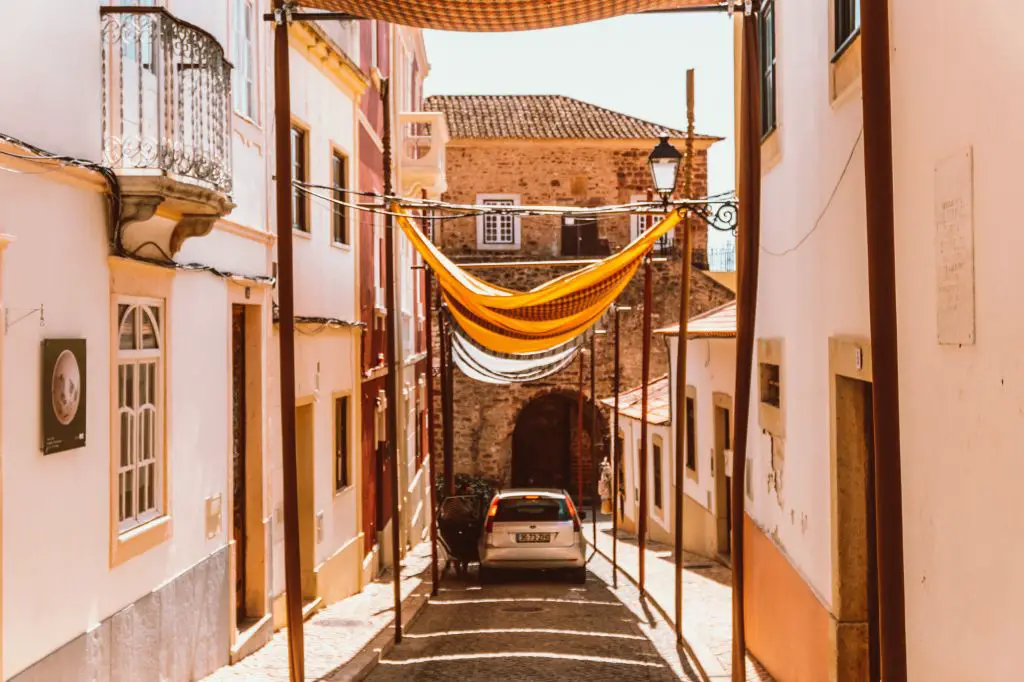
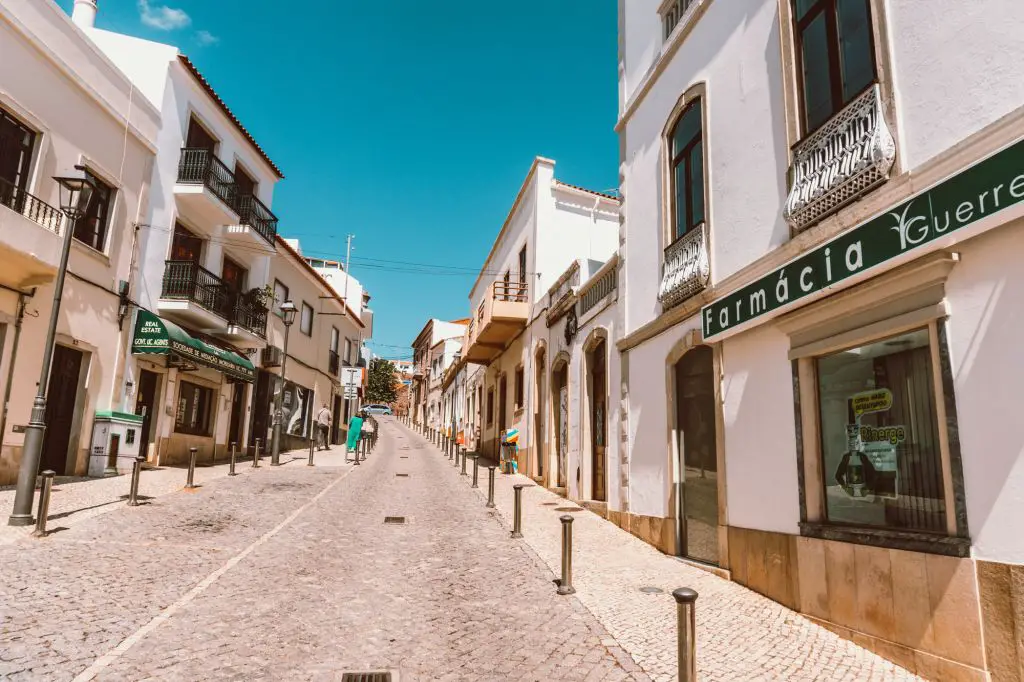
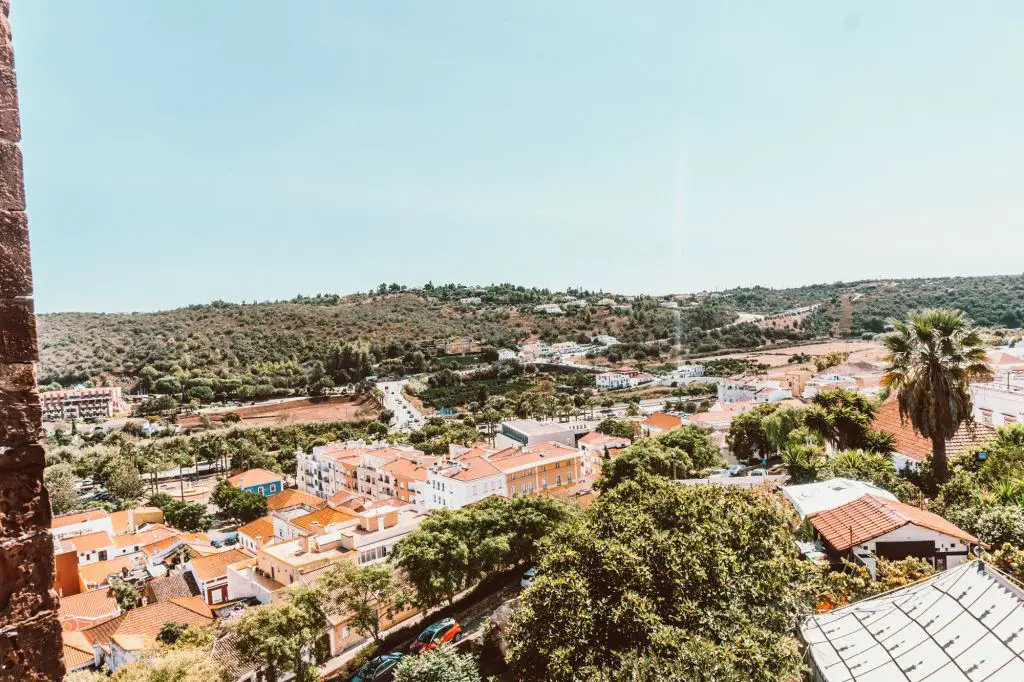
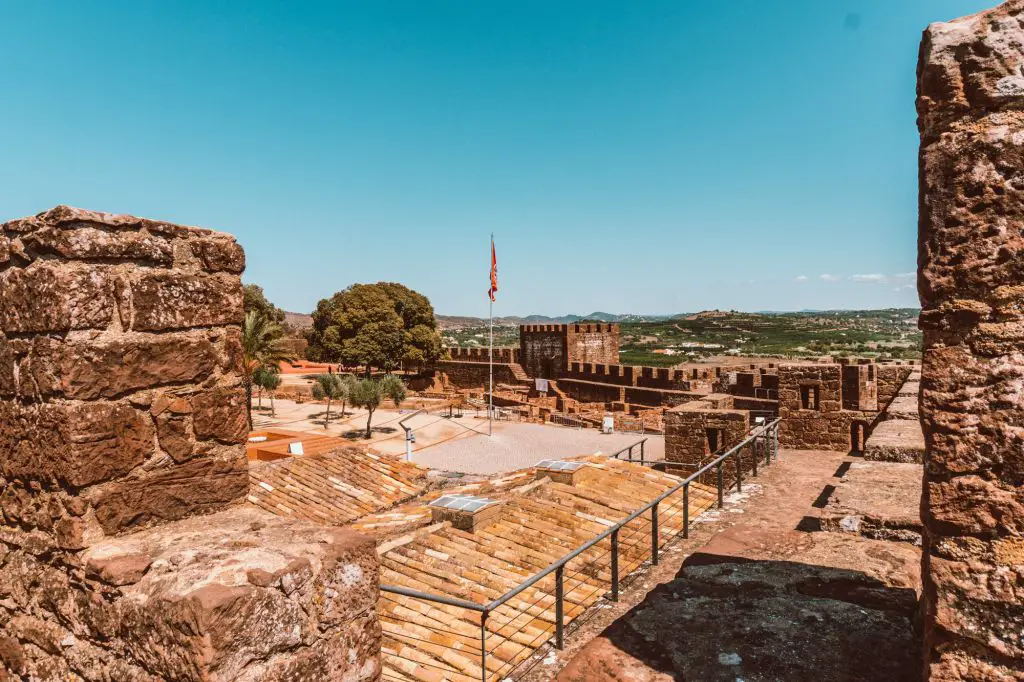

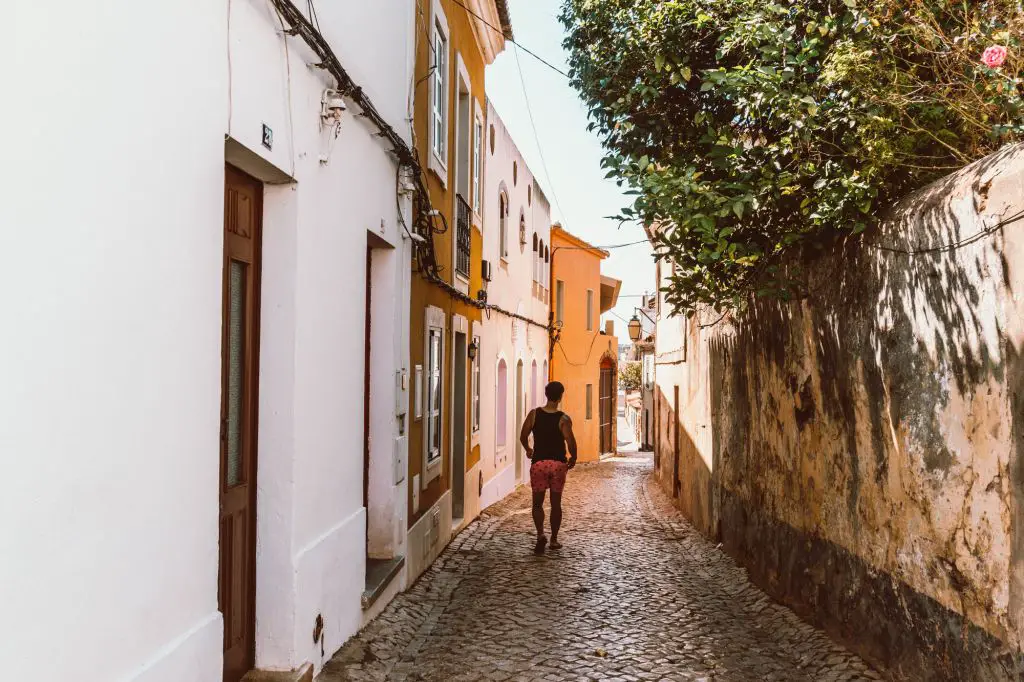
Turns out it’s a good decision!
Ferragudo Town
Without a doubt, Ferragudo is the most idyllic and prettiest town in the Algarve. Like Carvoerio, it was a traditional fisherman’s town that has been turned into a tourist town but there is still a fishing industry here.
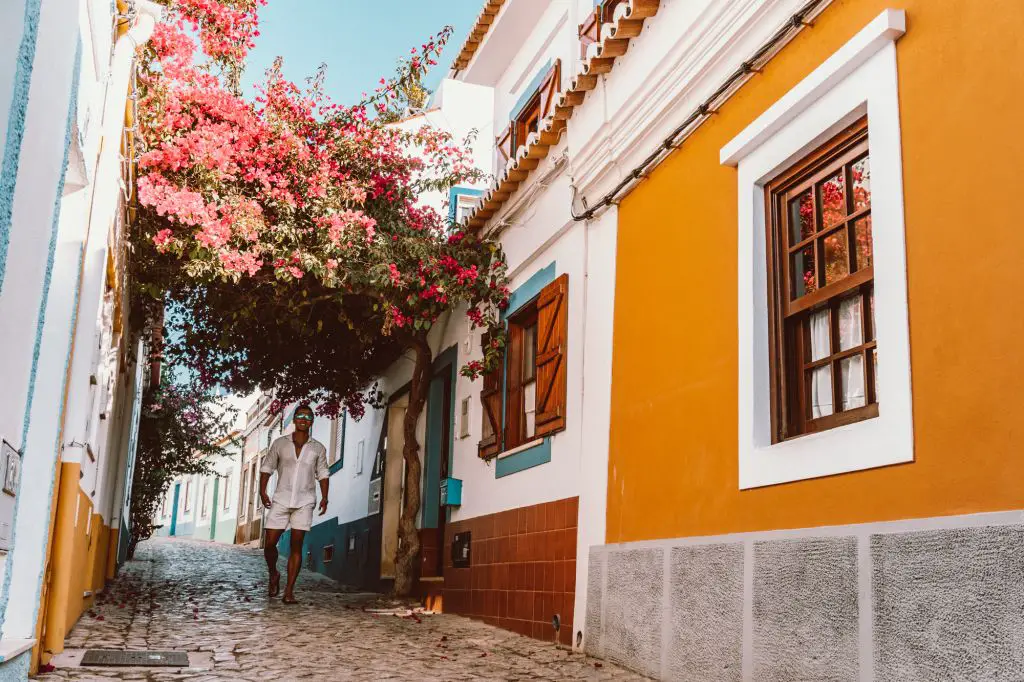
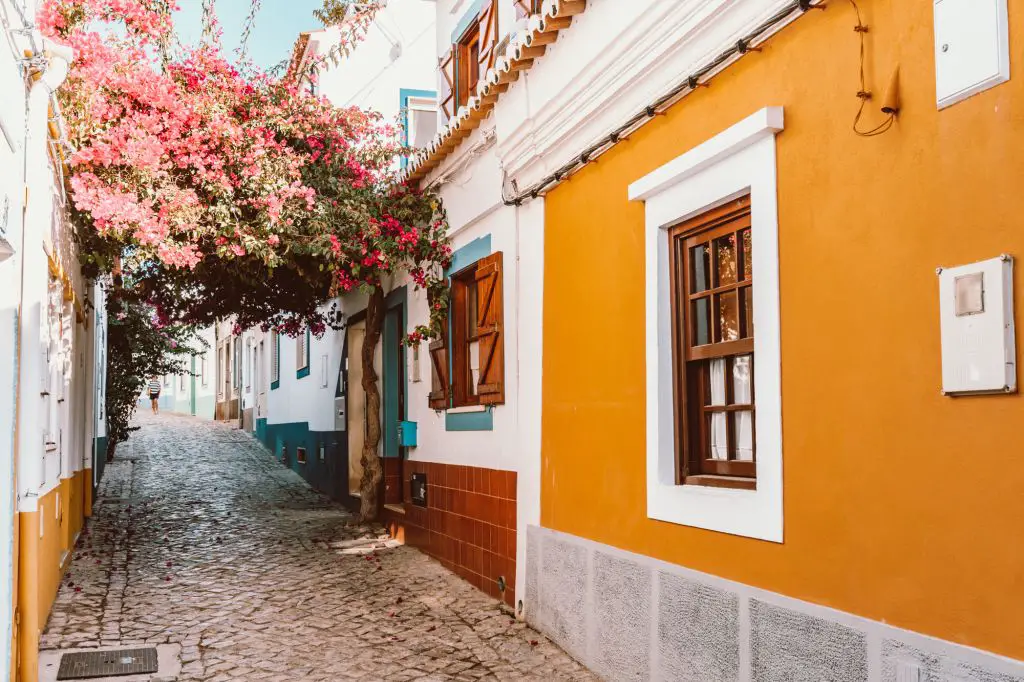
The town is built along a hill and offers beautiful traditional Portuguese houses, cobblestone streets, and colorful bougainvillea trees. Walking through the narrow streets of the town really reminded me of being in the Greek islands which is probably my favorite part of Europe. The Portuguese houses are more colorful however but the overall feel is perfect for those that want to take beautiful photos and be in a more relaxed setting.
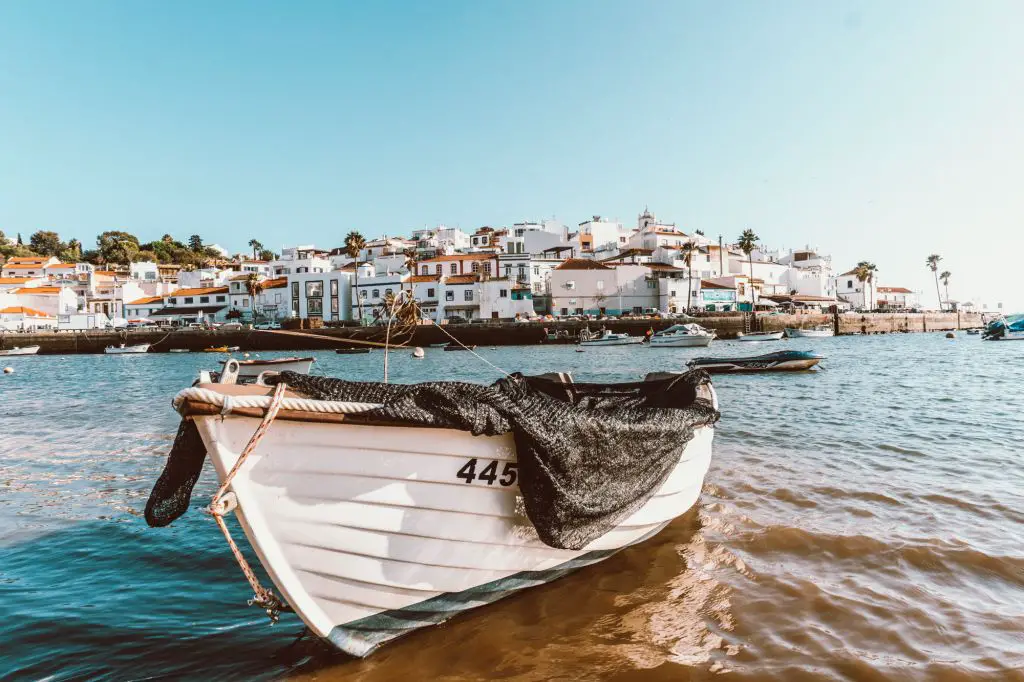
Ferragudo still offers plenty of restaurants and bars to keep you entertained so if you’re looking for a quiet getaway surrounded by beautiful traditional houses this is your stop.


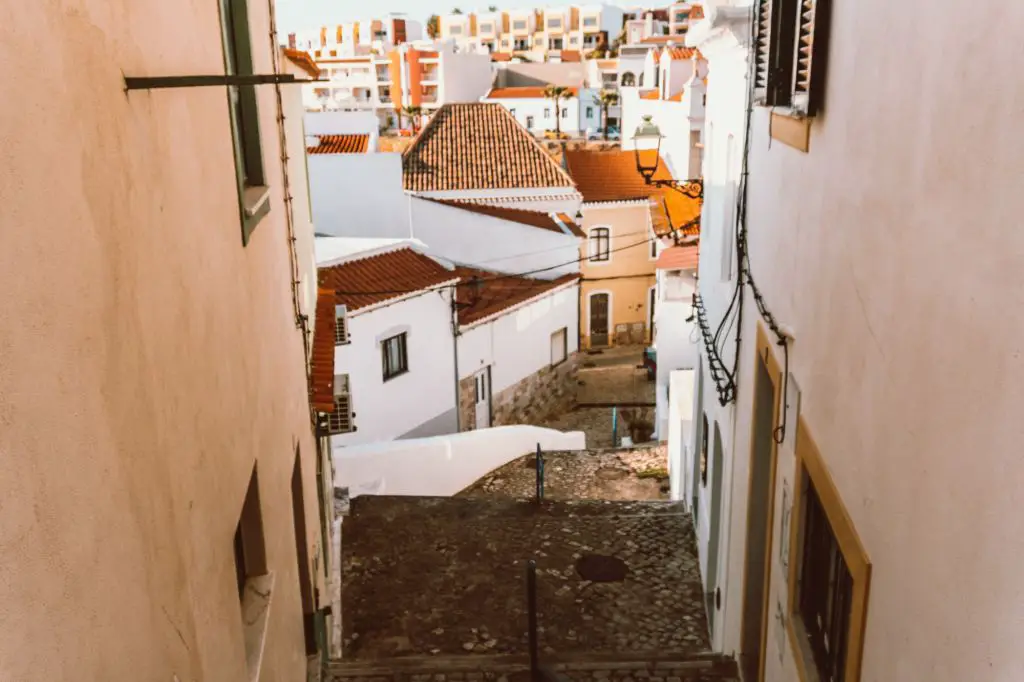

Portugal Itinerary Day by Day
Just to recap, this itinerary from above is great for people with 2-3 weeks to travel through Portugal. It is not for everyone and not everyone will want to travel at this pace (whether they prefer to go slower or faster). This is simply how I would plan my trip around Portugal.
This is the day by day breakdown of everything that I did
Day 1: Land in Porto, explore Porto area
Day 2: Full day in Porto
Day 3: Full day in Porto
Day 4: Porto to Guimares
Day 5: Guimares to Douro Valley
Day 6: Full day Douro Valley
Day 7: Douro Valley to Obidos stopping in Aveiro and Nazare
Day 8: Obidos to Lisbon
Day 9: Full day in Lisbon area
Day 10: Full day in Lisbon area
Day 11: Day trip to Sintra
Day 12: Lisbon to Arrifana
Day 13: Arrifana to Lagos, stop in Sagres
Day 14: Full day around Lagos, Algarve area
Day 15: Full day around Algarve
Day 16: Lagos to Carvoeiro
Day 17: Explore around Carvoeiro area
Day 18: Full day in Algarve area
Day 19: Drive back to Porto from Algarve
Day 20: Fly home
Portugal North and Central (Lisbon and Porto areas)
What if you don’t have nearly three weeks dedicated to traveling Portugal? It’s no matter, simply pick two of the regions you are keen to visit and focus on those. I think personally, if I had to pick two areas to go to, I would choose the Lisbon area and the northern part with Porto. I think the Algarve is beautiful for sure but it is not as unique in what it has to offer as Porto and the Douro valley does. I think beaches in Greece for example are much more beautiful for a beach destination in Europe.
Nevertheless, if you are dying for a beach getaway with beautiful water and views, then skip Porto and focus on the Algarve! It all just depends on what floats your boat.
One week Porto and Lisbon itinerary
Day 1: Land in Porto, explore Porto area
Day 2: Full day in Porto
Day 3: Full day in Porto
Day 4: Porto to Guimares
Day 5: Guimares to Douro Valley
Day 6: Full day Douro Valley
Day 7: Douro Valley to Obidos stopping in Aveiro and Nazare
Two week Porto and Lisbon itinerary
Day 1: Land in Porto, explore Porto area
Day 2: Full day in Porto
Day 3: Full day in Porto
Day 4: Porto to Guimares
Day 5: Guimares to Douro Valley
Day 6: Full day Douro Valley
Day 7: Douro Valley to Obidos stopping in Aveiro and Nazare
Day 8: Obidos to Lisbon
Day 9: Full day in Lisbon area
Day 10: Full day in Lisbon area
Day 11: Day trip to Sintra
Day 12: Lisbon to Arrifana
Day 13: Arrifana to Lagos, stop in Sagres
Porto Central and South (Lisbon and Algarve areas)
Here are some itinerary ideas if you are keen to travel the central and southern parts of the country.
One week Lisbon and Algarve itinerary
Day 1: Land in Lisbon, explore Lisbon
Day 2: Full day in Lisbon
Day 3: Full day in Lisbon
Day 4: Lisbon to Arrifana
Day 5: Arrifana to Lagos
Day 6: Full day Algarve
Day 7: Full day Algarve
Day 8: Drive back to Lisbon
Two week Lisbon and Algarve itinerary
Day 1: Land in Lisbon, explore Lisbon area
Day 2: Full day in Lisbon
Day 3: Full day in Lisbon
Day 4: Day trip to Obidos and Nazare
Day 5: Day trip to Sesimbra
Day 6: Lisbon to Sesimbra
Day 7: Sesimbra to Arrifana
Day 8: Arrifana to Lagos (stop in Sagres)
Day 9: Full day in Lagos area
Day 10: Full day in Lagos area
Day 11: Lagos to Carvoeiro/Albufeira etc.
Day 12: Full day in area
Day 13: Explore area east of Faro (Tavira, Olhao etc)
Day 14: Drive back to Lisbon



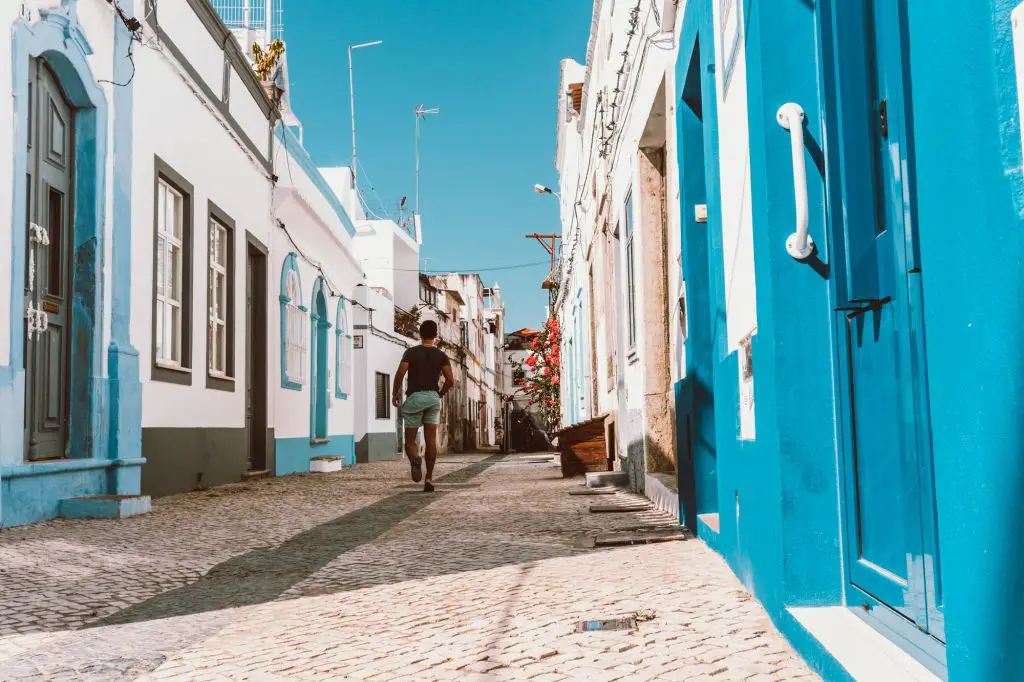

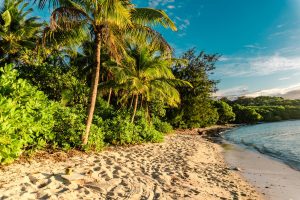


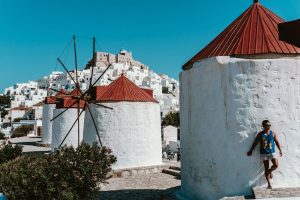

This has to be one of the best travel blogs I’ve read (and I’ve read hundreds) So detailed and I love the fact you don’t stick with ordinary itineraries and appreciate a slower travel pace. Thank you for taking the time to put this together! You’re my go-to guy from now on. Keep travelling and writing my friend! ????
Hi Kirsten, thanks for the kind words and glad you enjoyed the blog! Hope your trip to Portugal is gonna be great!
Hey Johnny, you saved me a ton of time and thank you for that.. One of the best written travel blogs, so detailed. I am planning for a 2 week trip and I will follow your plan..By the way great pictures and I see a nice retro tint to your pictures..do you mind sharing how you achieved that? is that a filter or some settings? thank you again
Hi Eddy, thanks for the kind words! Hope you enjoy Portugal as much as I did. I use Lightroom presets that I’ve designed for all my photos. I’m planning to have a page where you can download them all for free at some point in the near future!
Hello Johnny, First of all, I want to thank you for sharing your travel experience in such a great deal with the rest of us. My husband and I live in the Washington DC area and love to travel too. This time, we are planning to spend 2 weeks in Portugal in late April or May. Your Portugal travel blog provides the best itinerary and detail which has saved me a lot of research time!!! I realized that I can not see most of Portugal in 2 weeks. Do you suggest picking the Lisbon area and North area (port and wine country) or Lisbon area and south of Portugal? We have traveled to many wine regions in France, Italy and Spain. We do consider ourselves foodies, natural and history lovers. Any suggestions?
Another “greedy” option is to travel from Port to Faro following your guide but skip some areas. I hope to pick no more than 4 places to stay so we do not have to pack and move every day.
Thanks in advance!
Best regards,
Eileen
Hi Eileen! Thanks for the great words. It’s so tough to decide between the eternal question of visiting north or south. I think in apr may time would be good to see the algarve as it is heading into the season without the crowds. If you want more of a traditional European adventure then Porto and Lisbon would be your best bets. If you decide to do everything, id just base yourself in Porto, make day trips to the Douro valley and other towns. Then Lisbon and surrounding sights, then somewhere in the algarve in the end. Definitely doable as well!
Johnny, Thank you so much for your valuable advice! I will try to visit Porto, Lisbon and Algarve regions and pick fewer places to see. Hope it will work out. Eileen
This is fantastic info and very well written. Thanks so much for this. My Wife and I just retired. Live in BC Canada. Have never travelled to Europe and its time! We want to go from May 27 to June 18. We are flexible. Think we will start in Porto and fly out of Lisbon. Just a little unsure where we should stay along the way and for how many nights. Does this look about right? Thanks again!
Porto 3 nights
Guimares 1 night
Douro Valley – 2 nights
Obidos 1 night
Lisbon – 4 nights
Arrifana – 1 night
Lagos – 1 night
Carvoeiro Town – 5 nights
Lisbon – 1 night
Hi Mike! Glad to hear you’re finally traveling! I grew up in Nanaimo bc funny enough.
For your itinerary, It looks very sound and think will def let you get good experience of the country. Depending on when you’re flight home is on the last day you might not even need to spend a night in Lisboa. It is just a 2.5h drive from carvoeiro to lis airport